


The advent of paintball tournaments in stadiums may seem like a natural evolution but the shift from the woods took 15 years to truly settle in.
The first tournament to take place on artificial terrain was imagined by the English paintball company WDP in 1996 in Birmingham in England. For the first time, there were stands, and recognizable arbiters making gestures understandable by all and armed with speakers to explain the game to the public. As well as creating from scratch a symmetrical playing field and putting the players in a new environment, this new style of game brought paintball to the mainstream. Indeed, in the mid-nineties, Paintball was still a relatively obscure underground game. Finally, now, everything was open and visible; there was almost no need for game explanations.
Of course at the time of this first tournament, most of the matches still took place in the woods rather than on artificial terrain. It was quite a sight to see players turn up in full camo gear on the new futuristic playing fields.



The Frenchman Laurent Hamet perfectly understood the spirit and the attraction of these types of tournaments. He organized the first tournament to be played exclusively on artificial terrain. Furthermore, he actually created the concept of tournaments as they are today. With inflatable structures, paintball can be played anywhere, in any stadium, on the same field as football games. During the first years of the’ stadium invasion’, the Toulouse tournament was spotlighted as a reference in terms of organization. No other event came close to this yearly game in the Southern French city of Toulouse. Paintball owes a lot to this tournament and its organizer. The major advantage of Laurent Hamet’s product is that it can be dismantled and transported easily, a completely new concept of a paintball field a playing space that is easy to transport, set up, dismantle and that additionally offers fantastic advertising support was a god send at a time when Paintball was truly taking off as a sport.
The game’s concept is so at one with its time that it can take over unexpected places according to current fashions. An example of this is the Toronto Skyball, where the word arena suddenly takes on all of its full meaning; being there is like being projected into a futuristic Roman arena. Even the Disney theme parks have got in on the act, providing the space for tournaments within their parks (Wide World Sport in Disney World, Orlando and Euro Disney, Paris). The development of the media coverage attracted sponsorship from non-paintball brands, which 10 years before could never have imagined associating their image with paintball.




With the advent of inflatable structures – and everything that went with them: stadiums, specific outfits, ‘sports’ paintball rules- the game underwent a split. From then on, paintball was divided into two categories: Airball and Wargames in the woods.
It was around that time that paintball started being linked to the sports industry. Tournaments were not only encounters between players; the whole industry was involved. Each brand was competing in style and audacity to show up with the best stall at the trade show. On each team there was at least one person working in paintball, so where better to chat business than at a tournament where all the big brands were present? Tournaments like the one in Orlando soon became the most important world paintball meeting points. The tournament, which was the final event of the National Professional Paintball league (NPPL) in October each year, shone not only with its sporting spirit but also with its trade show. Each manufacturer would come and present their upcoming collection of new gear as well as DVDs and so on, and all in grand style.
The NPPL then gave the concept more breadth by organizing tournaments in prestigious cities such as Atlantic City, Las Vegas, New York, San Diego, Los Angeles and New Orleans.
As the years went by, the inflatable arena became the standard competition field and all the tournaments took place on Sup’airball.
Today, there are two types of tournaments: competition paintball and leisure paintball. Teams have specialized in playing exclusively on fields with inflatable structures and some have even made it their career, like the American team ‘Dynasty’. This increased the budgets needed for tournaments; for instance, the budget required for teams playing on circuits like the “PSP USA” or the “Millennium Three Europe” range from 50 000$ to 500 000$!
In 2OO5, Xball arrived on the scene, created by two Canadians, Richmond Italia and Mike Ratko.
This was the beginning of ‘sports’ paintball; more of a physical sport than the other types of paintball in the sense that it requires greater stamina and more technical and physical training. The idea behind the game is simple, a race limited by time to capture a flag on a much smaller playing field. Add to the mix inspiration from other games such as hockey and American football and a referee with a flag to signal penalties and you get a fast paced, dramatic and easy to understand game. The clarity of the game progession is added to by a scores board which signals, points, game time and penalties for the greater understanding and excitement of the public. This was a revolution because it meant that a team could afford to lose the first points of the game and still win the match. Strategically and tactically this changed everything. Chance, refereeing errors, bad starts, all became lesser factors and only the truly better team emerged from the arena triumphant.
The concept was launched at the IAO (International Open Amateur-Pittsburgh) in 2002 by its creator Richmond Italia as a ‘Nations Cup’ where the best players from around the world were brought together to compete and represent their countries.
A single year sufficed for XBall to make its mark in the United States (PSP) and in Europe (Millennium). Certain changes were brought to it over time by Mike Ratko and Laurent Hamet, who rewrote some of the rules ( Xball light) to make the game easier to play. This ‘light’ version is now known as Race 2.
Another important aspect of playing in a stadium is the public. It’s very gratifying and exciting for the players, who have spent each and every weekend training for the event, to finally compete, while being encouraged by the cheers of onlookers and fans. The level to which the game is played has hence increased over the last few years. Techniques, strategy and tactics have been codified and a paintball match has as many different aspects to it as a football match these days. Each action, move and element has a name and yet, when you enter the field you never know what you are going to get, or how the game is going to unfold. It could last 15seconds or 10minutes, you could win, you could lose, you could soar with triumphant pleasure or sink with the pain of failure.
This book is going to take you on a journey through the world of paintball.
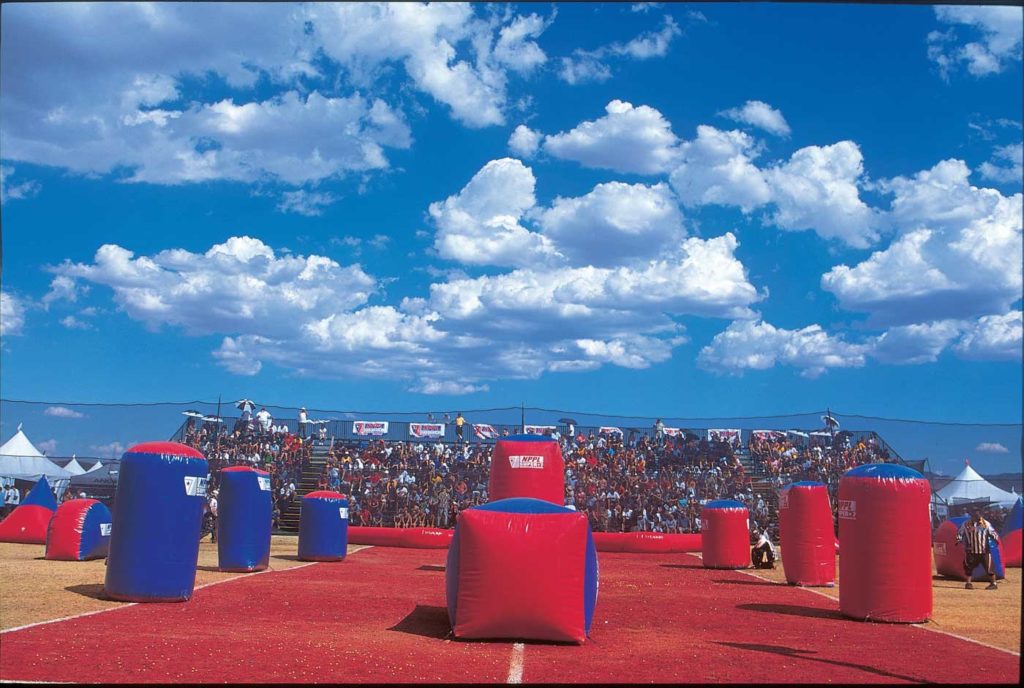

Walking the field has always been an intricate part of playing paintball, whether you are playing for fun or trying to win a championship. Walking the field consists in scrutinizing the playing area to find its strengths and weaknesses. Once these have been determined, you can figure out how to play the field according to your skill set. This was actually the first thing I ever did in paintball. We were all getting ready to play and there was some down time, so I went out, looked at the field and tried to figure out how to play it; where I could hide and how the opponents would try to attack. Back in those days, finding the strong side of the field often consisted in finding the side of the field that had the most natural cover. With lots of trees and bushes to hide behind and deflect the paint, you have a huge advantage over a team sitting out in the open. The old Ironmen had a saying : « thick to thin to win. » Basically, it meant that if you started on the thicker side of the field, you had a better chance of winning. In addition to thick vegetation, there are other advantages like the high side of the field. You would never want to try to push up a hill against opponents, they would have far too big an advantage. Things have changed over the years, but people still walk the fields and it’s still a very important part of the game. Yet, it has changed, gone are the days of altering the bunkers to give yourself an advantage or tying a ribbon on a tree marking what height to shoot so that you could get the guy on the other side of the field, even if you could not see him.
Another thing that players looked for while they were walking the fields were sweet spots. Sweet spots are open areas on a field that new players will run through to get to a key bunker. These spots are called sweet spots because they represent your best chance to eliminate opponents early on in a game. They will have to walk or, most likely, run through this spot so you get as many of your team members as possible to shoot paint at that spot. If you can shoot out one or two players on the break, then you obviously have a huge advantage in that game. Almost as important as sweet spotting is laneing. There is some confusion about the difference between the two. Sweet spotting takes place on the breakout and laneing during the game. Laneing is about finding a gap between two bunkers; the bunker that an opponent is in or will be in and the one they want to go to. Gun fighting with your opponent is risky business but shooting at them as they try to move from one bunker to the next is like shooting fish in a barrel. Finding the key lanes on the field and then finding the bunkers that can best control those lanes are paramount to a successful game plan. Yet keep in mind that as you figure these out, so do your opponents so you have to plan accordingly.
Over the years, the game has moved out of the woods onto hyperball fields and then airball fields. You’d think that because the fields are supposed to be mirrored which means that bunkers on both sides of the field are identical you wouldn’t have to really walk the fields because there wouldn’t be an advantage or a disadvantage. Well, that couldn’t be further from the truth. At least for now, the fields are never perfect , there is always an advantage or a disadvantage. It could be as simple as figuring out which side is staring into the sun in the morning or late afternoon. It could be that on one side of the field there is a key shot that isn’t there on the other side. Teams go out with their maps and pins, pace off distances and look at lines to really try and understand exactly how the field is going to play out before the first ball is ever even shot. The better prepared the team is going into their first games, often is what gives them an advantage over their opponents. Once a team has a really good game plan based on walking the field, they can change it as they play games and apply what they learn from playing the field.







One of paintball’s legends is Bob Long. He is larger than life as a player, captain and manufacturer. One of the things that made Bob famous was his ability to read a field better than anyone else. Somehow, he was able to go out, look at a piece of land, and understand how the game would be played. He then had the ability to make game plans on how to attack or defend different areas of the field. It was incredible to watch him walk around, duck down, look at things that no one else could see, and then make a plan based on what he saw. It was even more impressive to watch the results. I watched his team play in Oregon at a big event. The field had a big hill, with the fifty yard line on top of hill. While you played, you couldn’t see the players on the other side of the hill. Bob walked the field and told all his players where to go and where to shoot. They shot out all their opponents without ever seeing them and won a 10-0 victory. This is one of the most impressive field walking displays that I have ever witnessed.
Nowadays, teams have a big advantage and field walking isn’t as important as it used to be. Teams now get to practice and play the fields before they go to an event. The upside is that this makes for better games at the event because everyone knows how the field plays and they can go out there and compete at the highest level. The down side is that it takes some of the skill out of the game, as do automatic markers. With auto guns and without fields to figure out, you don’t have to be very good to play at a high level. Some of the leagues are talking about trying to go back to not sending teams field layouts before events and making them walk the fields to bring the level of play back up to where it used to be. Whether it will be done or not is up in the air right now but if they do, try and get Bob Long on your team, you’ll have a huge advantage over the competition.
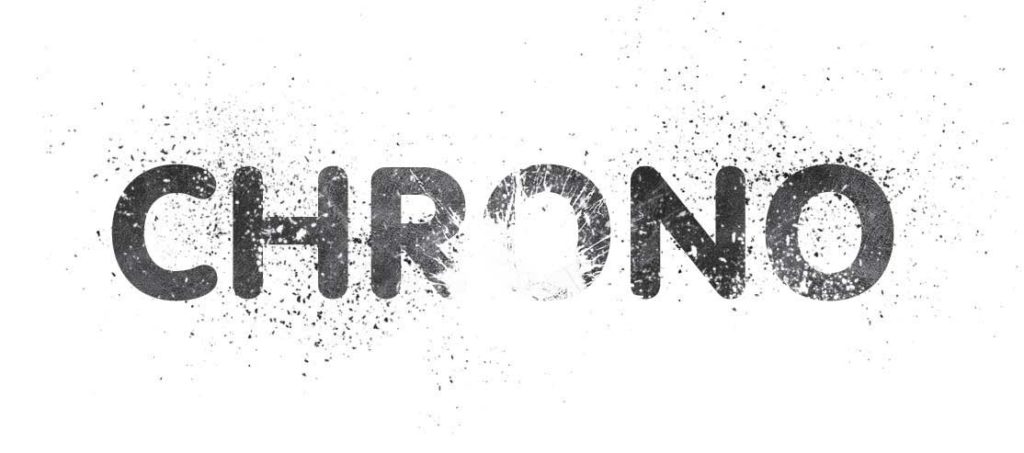
A chronograph is an instrument that tells the speed of a moving object when that object is propelled over it. Usually, they have a series of beams that the object travels over and then the time that it takes to go from one beam to the next is measured and that gives you the speed. The speed for paintballs is 300 fps that means 300 feet per second, which is about 204 miles per hour. That is the top speed that you can shoot your marker. Many fields have set lower speeds for safety, so that kids and people that play for the first time aren’t hurt or scared off. Chronos is the abbreviated term for chronographs. Chronos have changed over the years but the use and intent hasn’t. There are chronos that sit on a bench and that you shoot over and then there are the hand held versions. They are an integral part of safe play and should always be used. Most paintball guns can have their velocity adjusted so that they can shoot harder or not as hard. This is done because speed varies depending on the conditions, size, paintball pellets type and other factors, which all have an effect on the velocity of a gun. Shooting over the legal limit greatly increases the chance of injury and should not be done.
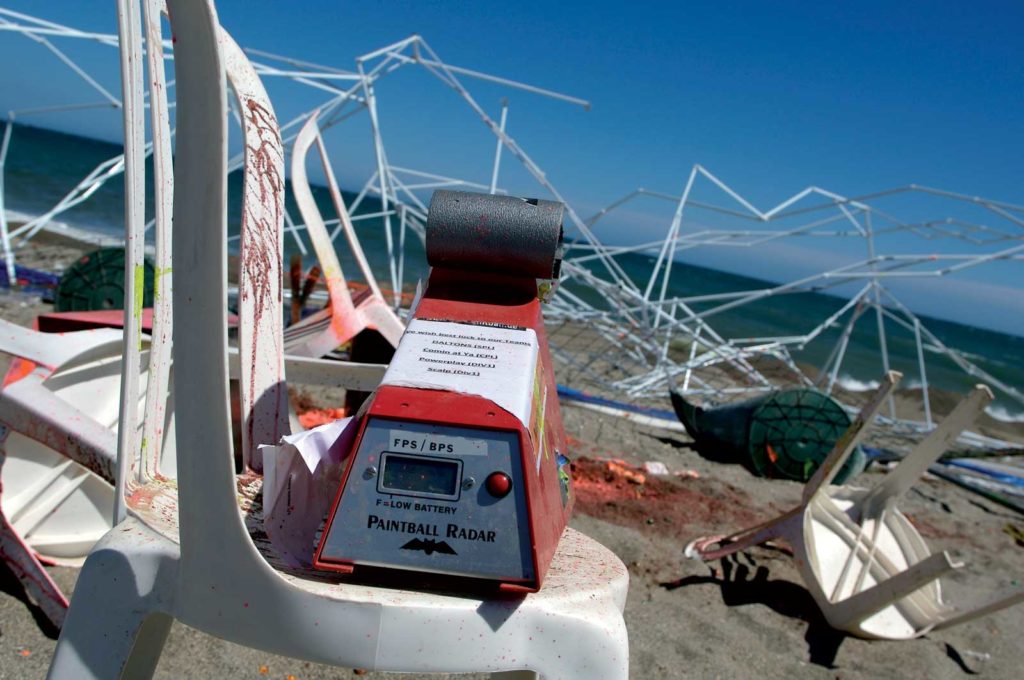
When you play at a tournament you have to crono your marker before you play to make sure that you are shooting at a safe and fair speed. There is an advantage to shooting harder than your opponent so people try and turn their guns up on the field or try not to chrono. When you shoot harder the balls travel further and faster making them much harder to avoid. Back in the old days, you also had to crono your gun after you played and many games were won and lost when you heard that beep saying that your gun was shooting over the legal limit. It was decided that too many games were being won and lost at the crono after the game instead of on the field so that rule was dropped. Now some of the leagues have devices that can tell from the side lines how fast your gun is shooting; so if you’re breaking the rules you get pulled out of the game. This is a great system; it encourages players to go out at the legal limit.






As the game of paintball evolves one thing that hasn’t- and probably won’t – change is the need to have some way of making sure that players and markers aren’t shooting over the legal limit. Players will always try and push the limit, and some will cheat, so it’s really important to make sure you’re playing at a field that has strict rules regarding crononing your markers at a safe speed.
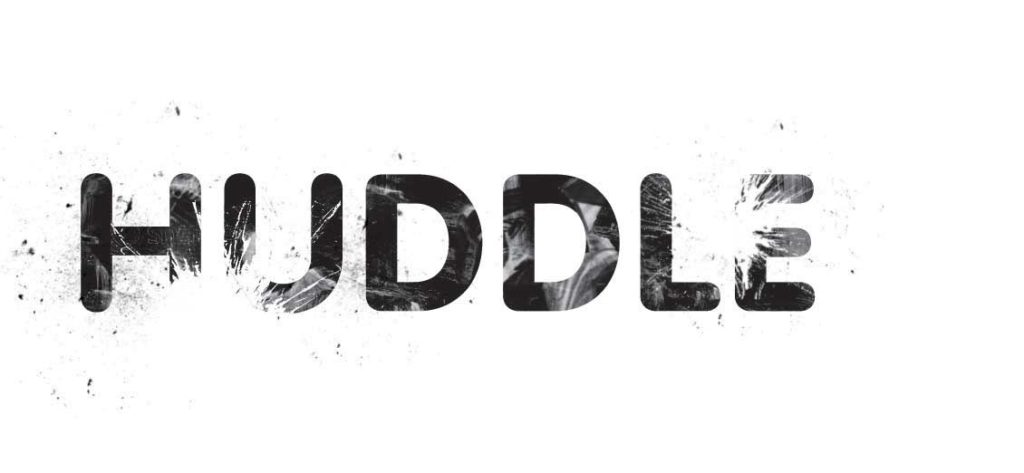
How do you know that you are in a group of really competitive guys and that you are probably going to win the game? A good indication is that when you look into their eyes, you see fire and hate; their voices crackle when they scream because it’s coming from their guts not their throats. Another good thing to look for is someone vomiting. Right before the game, all the players get together and attempt to raise their levels of desire, performance and swagger. Knowing that the other team is doing the same thing, you yell louder, look meaner and get more pumped up. You’re in the huddle; this is it the last chance that you have as a team to get everyone and everything on the same page before you go into battle.
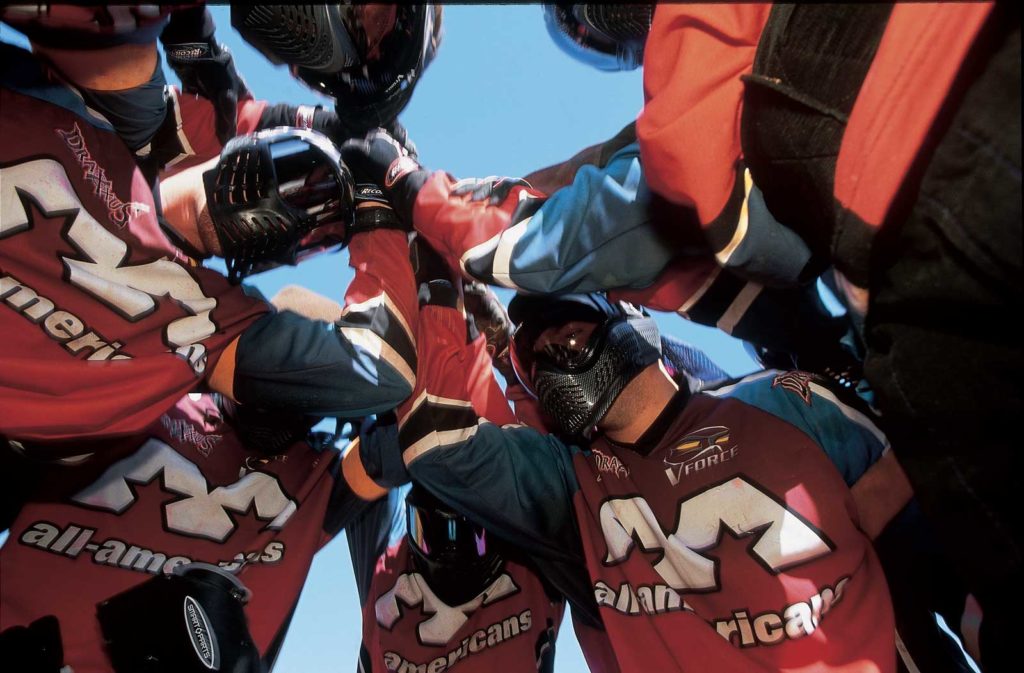
Every huddle is different and every huddle is the same. As different as each huddle is, so are the people in it. Some guys need to get fired up so when they yell, you yell. Some guys need to know what they have to do and how to do it. You may have told them a thousand times before but this is the one that matters. Some guys don’t need anything; they are just there to support the others that need it.
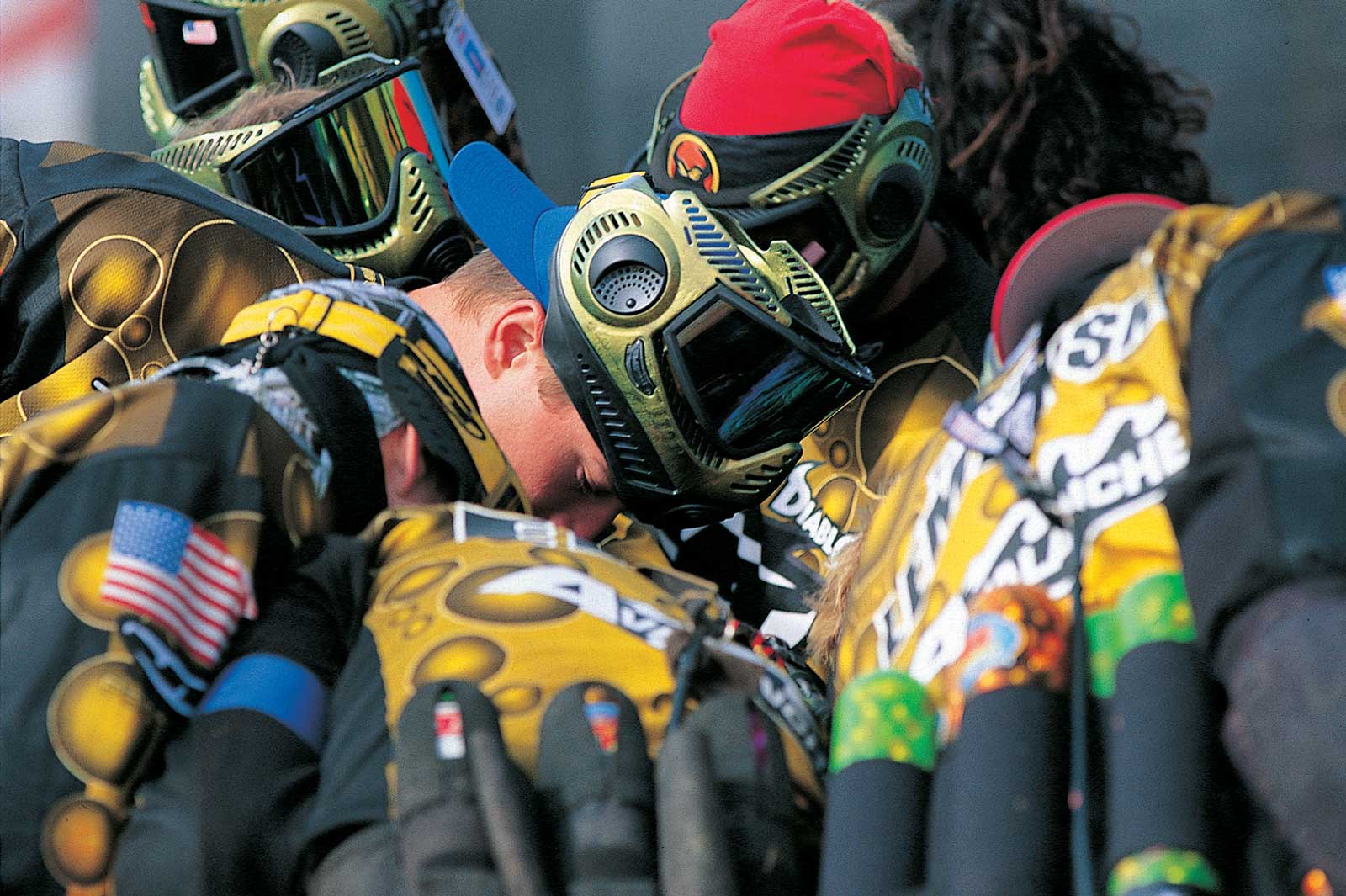




Before every game starts, all of the players from a team get together in a circle. Shoulder to shoulder, arm over arm. This is like a board meeting for the battlefield. You have your agenda to destroy the other team.You have your business plans go down the snake and kill everyone, and you have your titans of industry and your workers. Instead of a table, we use a huddle; instead of a boardroom, we do it on the field but the goal is the same. The goal is always the same: to win, and, like in business, it’s win at any and all cost. You don’t have to be reminded of this when you look across the huddle at a full-grown man with tears and hate in his eyes.

This is when you are the most alive if you are a paintball player. This is when you alone know if you have the stuff or not. You know how you feel before you play. The winners all have one thing in common in the ten seconds before every game, they know they are going to win.
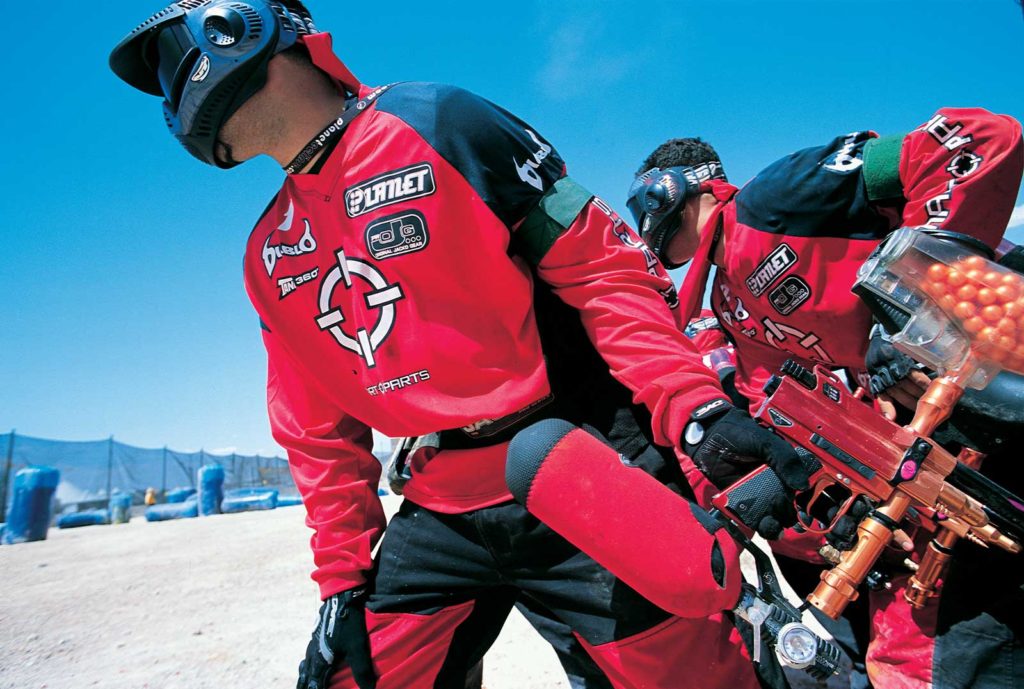
They may not know how or when but they know that no matter what they are going to win. The other guys on the team might not feel it; they might not believe it; but you know that if you have to, you will carry them or sacrifice them to get them to the win. If you’re getting ready to go out and play and you don’t have that feeling in your stomach – that feeling that tells you that you are going to win; that it’s already over but the other team doesn’t know it yet – then you didn’t train hard enough. So most of the time that is what confidence is. While you train and learn how to do things, and learn how to do them better than other people, you gain confidence. When you practice with your team, you gain confidence in yourself as much as in the other guys on your team. You build on this confidence little by little; sometimes you slide back and lose some of it, but then it comes back stronger. As you build your confidence during practice and by playing events, your skills improve and you learn more, making you more confident. The first time you play a tournament you might get smashed. You go home and you don’t know why you lost so you go out and practice and build that confidence back up.



The best teams have one thing in common, after they huddle up and the referee calls ten seconds and begins his silent count down, they all believe they are going to win. Maybe not every player on every team but the better the team is, the better chance there will be that all the guys in the huddle believe. They may look scared or nervous, they may look like they have no confidence, but they do. They have it where it counts, inside; they go into those games expecting to win and they, most often, do. They go into the game with the forgone conclusion that they are going to win, that they are going to play amazingly and that they are going to be super stars. It may not always happen but you can see the ones I’m talking about. When they lose, they look shocked or even confused because what’s happening doesn’t make sense to them. They knew in that ten seconds before the game that they were going to win. I guess the only problem is that the guys on the other team thought they were going to win too. In those ten second after the huddle and before the game starts, you can learn all you need to learn about yourself and you teammates and if you don’t like what you learn then fix it because champions are made in the ten seconds before the game starts!
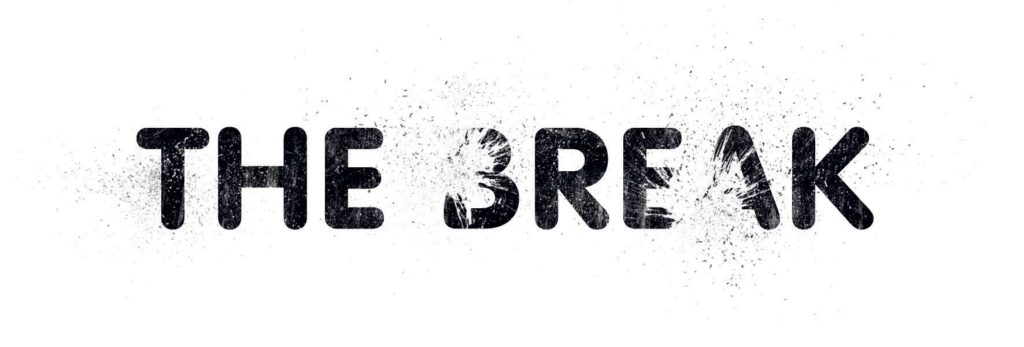
The break or the breakout is when you get to see if all of the planning, all of the preparation, pays off. You train, you condition, you scout the other team so that when the game starts, you have a better chance of winning than they do. Of course, while you have been prepping so have they so this is harder than just showing up; you have to show up knowing that you worked harder to get there and that you are going to win no matter what they throw at you. The breakout is different for each team and then for each player and position on the field. Everyone needs to get their head right so that they have the advantage going into the game. There is a countdown for the beginning of the game. Players take off the safety devices on their guns, start their timers and then go over in their mind what they need to do when the game starts. They fire their guns to make sure that they are working. There is usually a ten second count down. It’s the longest or fastest ten seconds ever. So many things are flying around in your head. You’re either supremely confident or scared to death. No one that competes is scared of being shot or getting hurt; they are afraid of losing or playing poorly and letting their team down.

The break is different for all of the positions on the field. They all have different goals and different responsibilities. For the front guys, it’s all about a quick start, getting out in front of everyone else. They have to run as fast and as low to the ground as they can; all the while avoiding the paintballs that are being shot at them. They have to stay alive and get to their spot before the other team gets set up and locks down the lanes so that no one can move. They have to get to their spot and make the other team pay for not shooting them out on the break. Before the game, they are trying to figure out how many guns are going to be shooting at them. They try and figure out whom it is that is shooting at them because some are better than others. Front guys always have a bunker to go to on the break but if they can go past that bunker because there aren’t good lines of paint in front of them; they keep going and break the game open. For the mid guys, it’s a little harder, they have to make a spot like the front guys but they also have to shoot at the shooters to help their front guys get to their spots. They also try and shoot the other team’s front guys. They also have to watch what their front guys are doing because if one of them gets shot, it’s up to the mid players to fill their spots as fast as they can. Mid guys have to have the speed of the front guys and the smarts of the back guys. In fact, they have to be just as good at both jobs. Before the game starts, they have so much to think about that sometimes I’m surprised that their heads don’t explode. The back guys have a lot to think about on the break too. They need to anticipate where the other team is going on the break; where the other team is going to go; how the players are going to run in order to get to that spot. They have to shoot their guns and make adjustments based on what they see, in an instant. Once they make or miss their shots, they have to let everyone on their team know what they have seen. How many players did they eliminate; how many did they lose? This all happens in ten to fifteen seconds. The front, mid and back players have to do all that they can to win the break and give their team the advantage and they have to do it with split second timing and supreme athleticism.
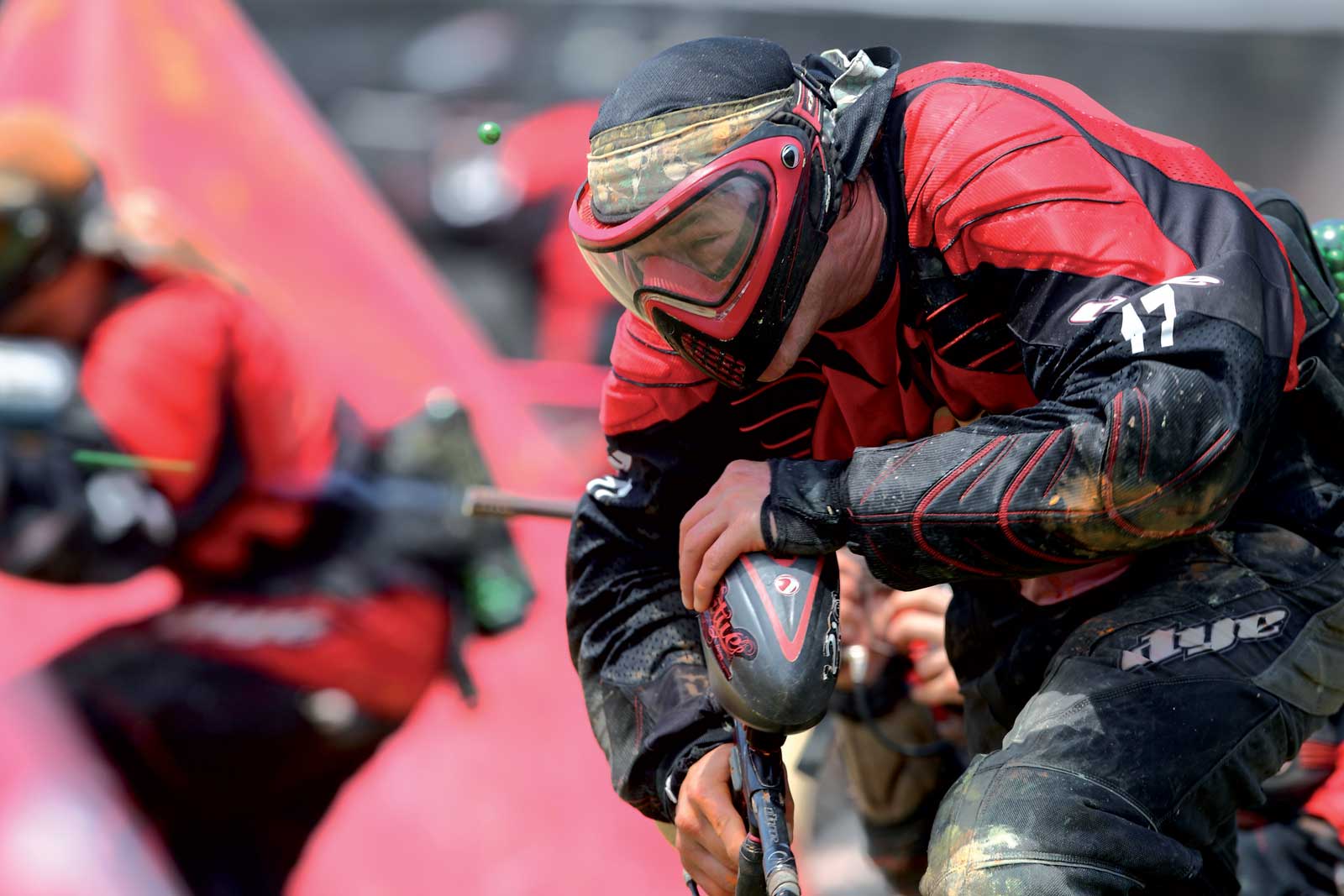



In some of the different formats that we play, like X-ball, the breakout is almost the whole game. X-ball is a five on five format with a wide field making it challenging to get outside to the corners on the break. Generally, each team will try and send someone out to each corner on the break. This will most often win or lose the point for the team- based on whether or not the team makes the corners and eliminates the opposition. A team with players outside on the break has a big advantage; they can trap all of the other team’s players in the center of the field and move up either side making eliminations as they go. So in this format the break out isn’t just important, it’s the whole game. If you win the breakout, you win the game so make sure you do. In other formats, like seven man, the break out is important but it’s not a win or lose proposition. Because you have more players and the field is longer, you can recover from losing a couple of people on the break – if your team has enough experience not to panic, run down the field and die stupidly. A team that loses a couple of players off the break just tries to settle in and lock up the lanes until they are equal on numbers and then they switch back to offence and get the job done.




There are three parts to any game: the beginning, the middle and the end. If you want to have a good middle and a good end, it starts with a good beginning. The most important part of any game is the breakout; this is where teams spend all their time trying to figure out how to beat you and you have to be smarter than they are if you don’t want that to happen. Teams that don’t spend the time or have the knowledge of how to win a breakout often don’t and then that game is lost as well. Take the time, get the experience and plan on winning the breakout and you’ll most likely win the game.
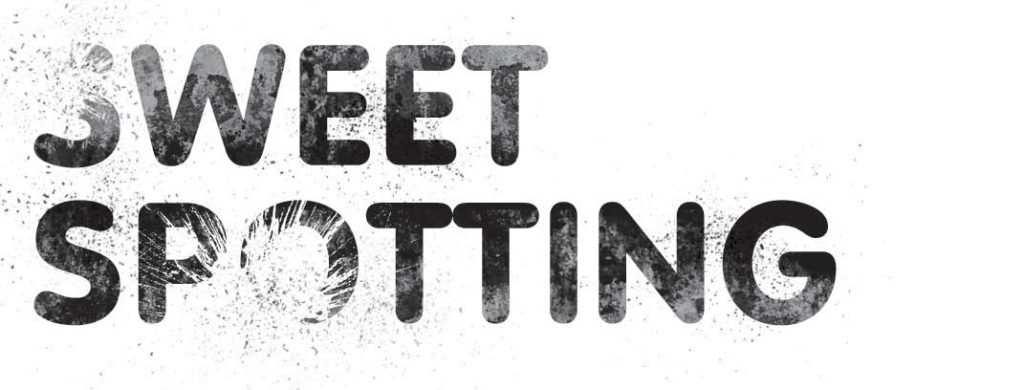
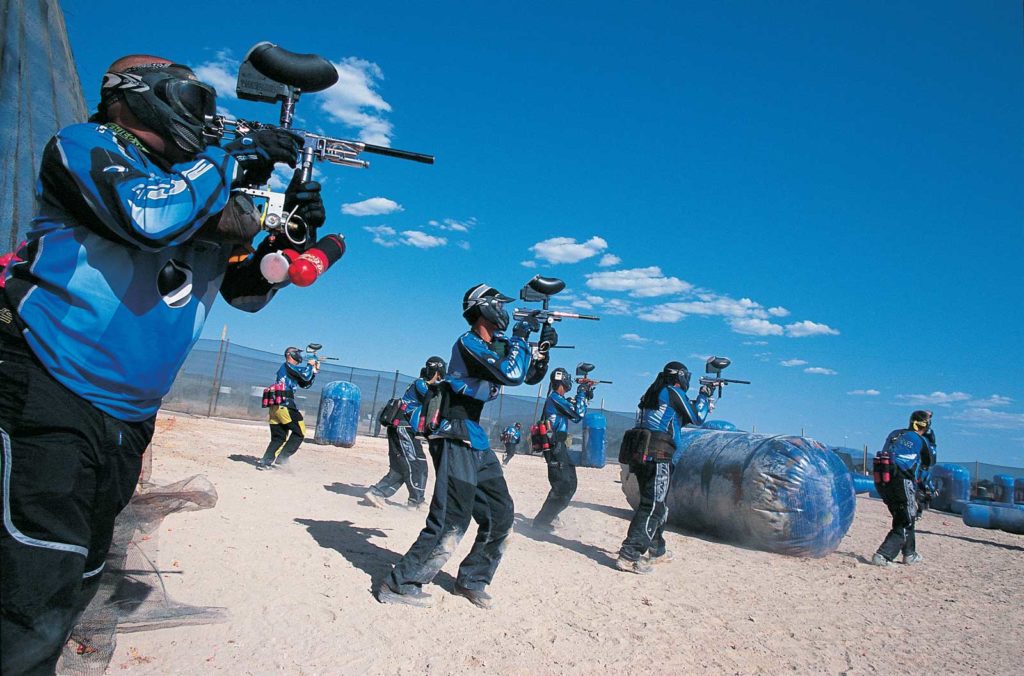
This is one thing that hasn’t changed much over the evolution of paintball, we still sweet spot the same way. We either shoot from where we start or we run to a spot and try to predict where a player from the opposing team is going to be. We try to beat them there with our paint so that when they do get there, they run into our paint. It’s an easy way to get an early elimination and that gives your team the early advantage. Now although the concept is easy, the application is often much harder. First, you have to guess when and where your opponent will go and then get your paintballs in the perfect spot.
This is one thing that hasn’t changed much over the evolution of paintball, we still sweet spot the same way. We either shoot from where we start or we run to a spot and try to predict where a player from the opposing team is going to be. We try to beat them there with our paint so that when they do get there, they run into our paint. It’s an easy way to get an early elimination and that gives your team the early advantage. Now although the concept is easy, the application is often much harder. First, you have to guess when and where your opponent will go and then get your paintballs in the perfect spot.






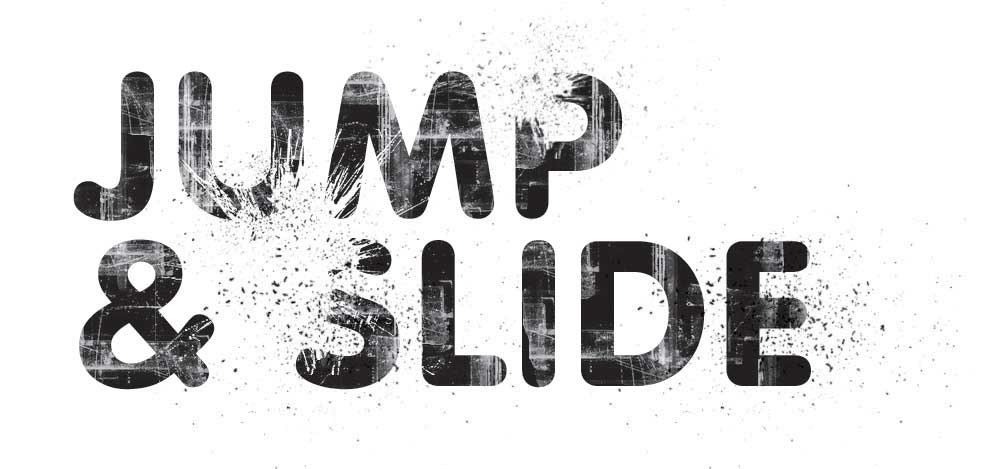
Some people aren’t sure if paintball is a real sport or just a game. What is the criteria for a sport anyway? You have to compete and there has to be some athleticism. Well, if you play paintball then you’re competing and if you have ever tried to sprint to the corner as you shot your gun, to dive under a line of paint and then pop up and snap your mirror; then you know paintball is athletic. Some of the coolest pictures I’ve ever seen have been of players running full speed almost parallel to the ground trying to avoid a line of paint. You think of the paint that someone is shooting at you like a squirt of water from a hose. That spray of water is between you and the bunker that you are trying to get to. You can go over it or under it but you have to get through it. This is hard, or at least hard enough, but you can’t see the line or if you can, only barely. You almost have to anticipate where the line is going to be and get over it or under it.
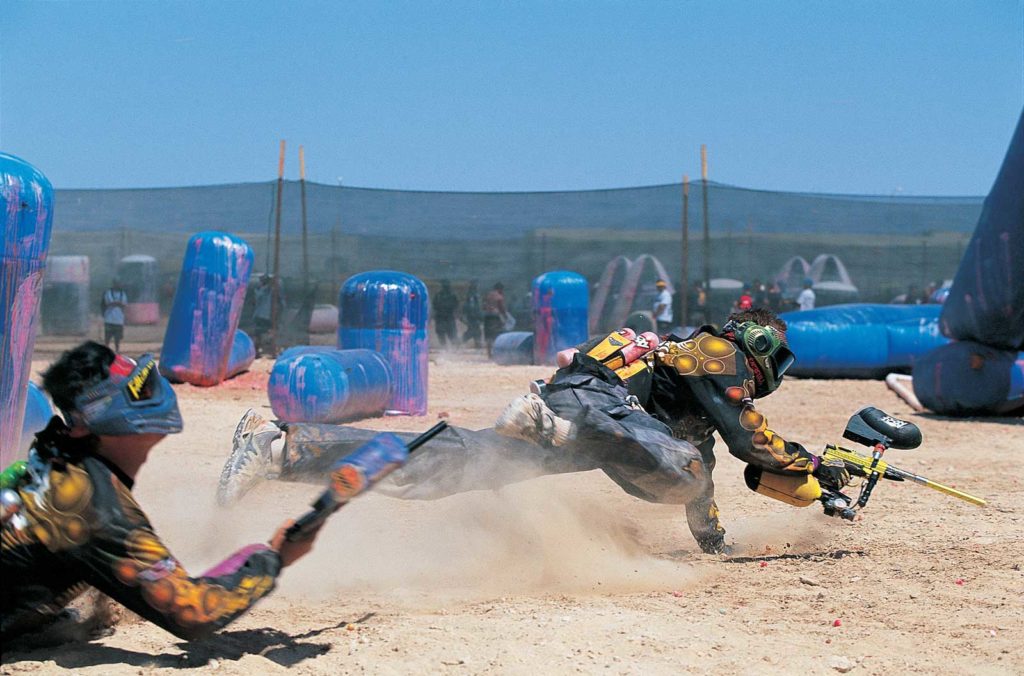
Sometimes there are two or three lines. Paintball players come in all different shapes and sizes but no matter what position you play, if you play paintball you’re going to have to run, dive and jump.






The faster you are and the more athletic you are, the easier it is to run and dive and jump but paintball isn’t one of those sports where you have to be the quickest or the fittest; but the more you are, the easier it is to play. The position you play in paintball is often based on your size and speed. Your ability to run fast and dive into spots of the field that others can’t make often makes you a very valuable asset to your team. If you can run, dive and jump faster than the other guys you’re playing against, your team is going to have an advantage. Sometimes, the little bit of advantage you gain from getting to your bunker faster than the other guy is all that it takes. There are lots of cool pictures of guys running and jumping or even sliding but the best are the ones where it has been raining. Everyone likes to play in the mud as a kid and we all did it, didn’t we? It’s even more fun to play paintball in the rain. When it’s wet out, there are puddles and it’s mad, you can slide a mile! You feel like a super hero tearing off to the corner and then sliding much further and faster than you ever would on dry land.
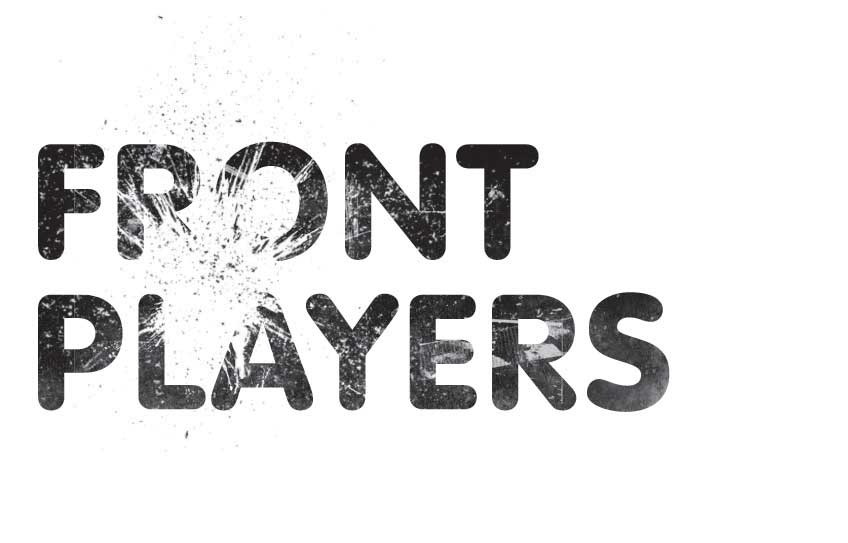
The front player holds a glory position similar to that of a wide receiver in a football game. These are the guys who get the chance to win the game from its beginning . They take all the risk and sometimes get all the reward. Being a front player has really changed over the years. Front guys have always been small and aggressive but as the game has become more of a sport and more competitive, front guys have had to too. They were once just little guys that liked to get in peoples’ faces. Now they are little mean guys that are super fast and super athletic and on top of that they have to have great cardio.
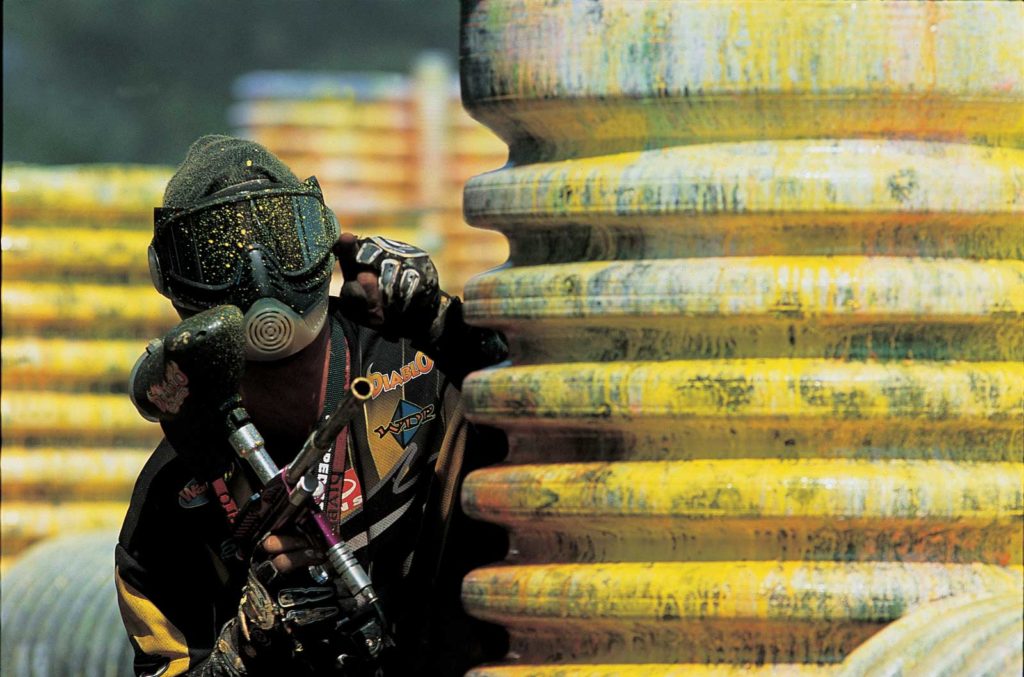
These guns sprint every time they play. In an x-ball match that means they are running a lot and not just jogging; they are trying to outrun both their opponents and the paint coming at them. Front guys also had to be pretty smart back in the day; I mean, you had twenty people on the field and half of them were trying to kill you. Front guys had to get to their spot, stay alive, but they also had to figure out how to make their next move. Front guys today still have to do that but take my word for it, on a flat field with no bushes or trees, it’s a lot easier. At least now you can see all of the players. Back then they often had to use their sixth sense to see the guys hiding in the jungle.
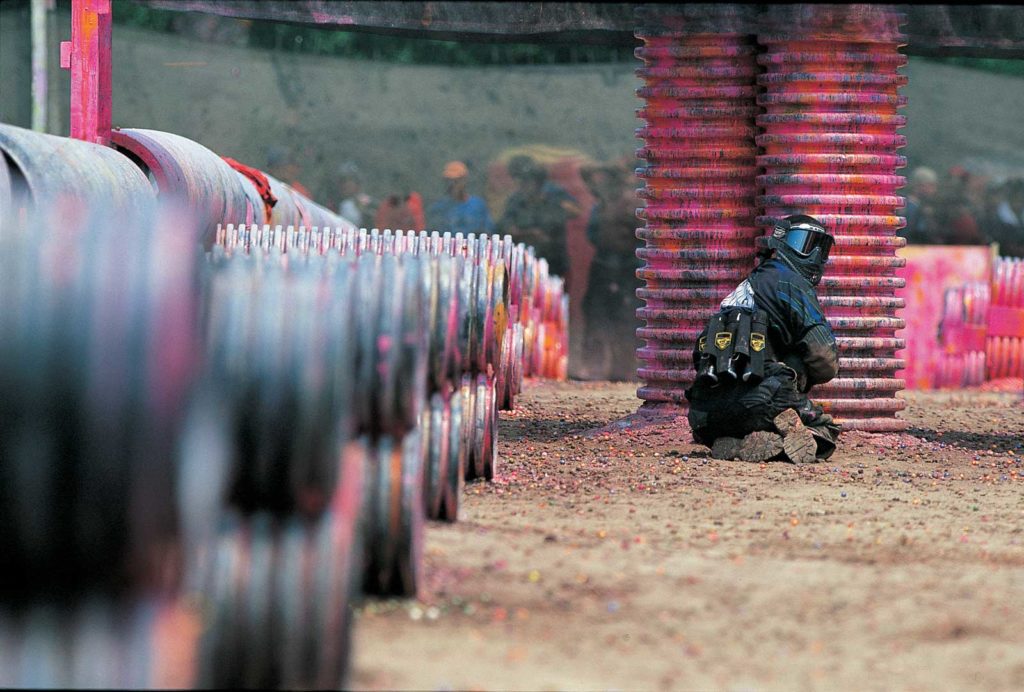
A good example of a really good front guy back in the day is Dave Youngblood. In his prime, Dave was probably 6’2 and 185 lbs. Even with that height and size, he could get to his spot. Once Dave got up there and everyone started shooting at him he would relax, talk to the guys around him and put together a strategy for pushing through. You had to be really good at communicating to figure all of this out while racing against the other team who was also working on a strategy. Finally, Dave and company would devise a plan and it was ‘go’ time. Everyone would gun, Dave would get up and go, get two or three guys off the field and walk to the dead box assuming the Ironmen would win – and they usually did. His approach was really deliberate and dangerous. Front guys today are forced to make much faster decisions because the games don’t last 25 minutes anymore. The front guys of today could play more than three seven-man games in the time it used to take to play one game. If they were playing x-ball, they could play 12 or more points in the same time frame. Another thing that has changed is that front guys used to be pretty fast and pretty agile as well as being smart. The new front guys are fast, really fast. They have to be because the guns are so much faster now. Front guys have to run very fast and very close to the ground to try to get under, through or around the lines of paint coming at them. Ten or fifteen years ago, when the auto-cocker was the gun of choice, players got one, two or ten balls shot at them now they have a wall of paint coming at them. It’s unbelievable what some of these guys do and how they do it over and over again.



Now I could argue who of the new front guys or the old ones were better but it doesn’t matter. They both are good at different things and they both were at the top of their game at the time they played. I would love to see someone with today’s speed and size play back in the day, it would be fun to watch. Probably the only thing that could stop him would be the craftiness of a front guy from back then.
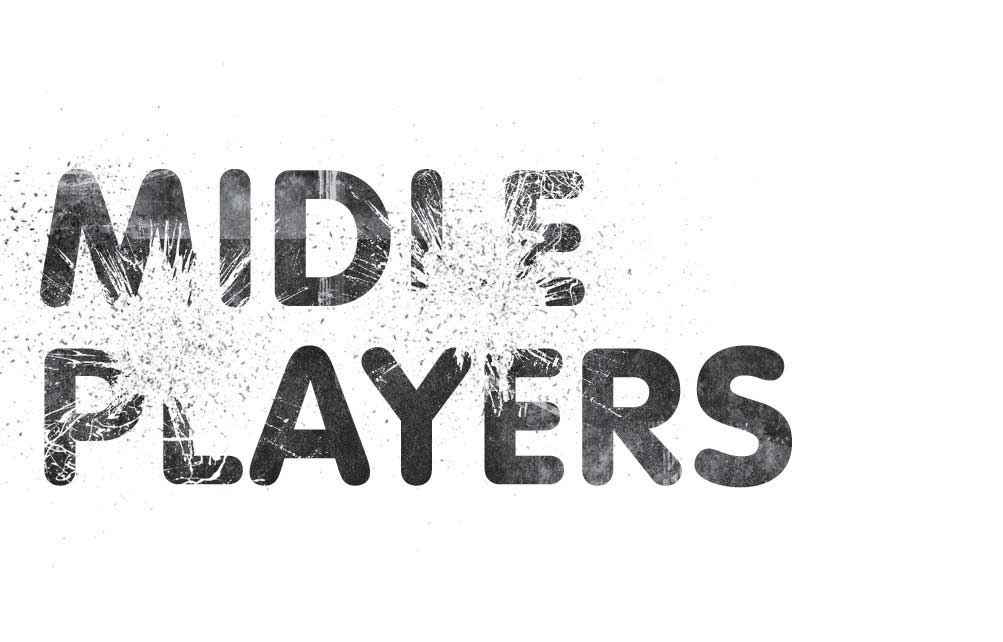
This might be the hardest position on the paintball field. I mean, it’s not hard to play but it’s really hard to be good at. The mid player has to have all the skills of a front guy and a back guy and, in addition to playing as well as the front and back guy, they have their own unique skill set as a mid player. There aren’t as many mid players out there as you might think. Out of all the mid players out there, there are only a few that are truly gifted.
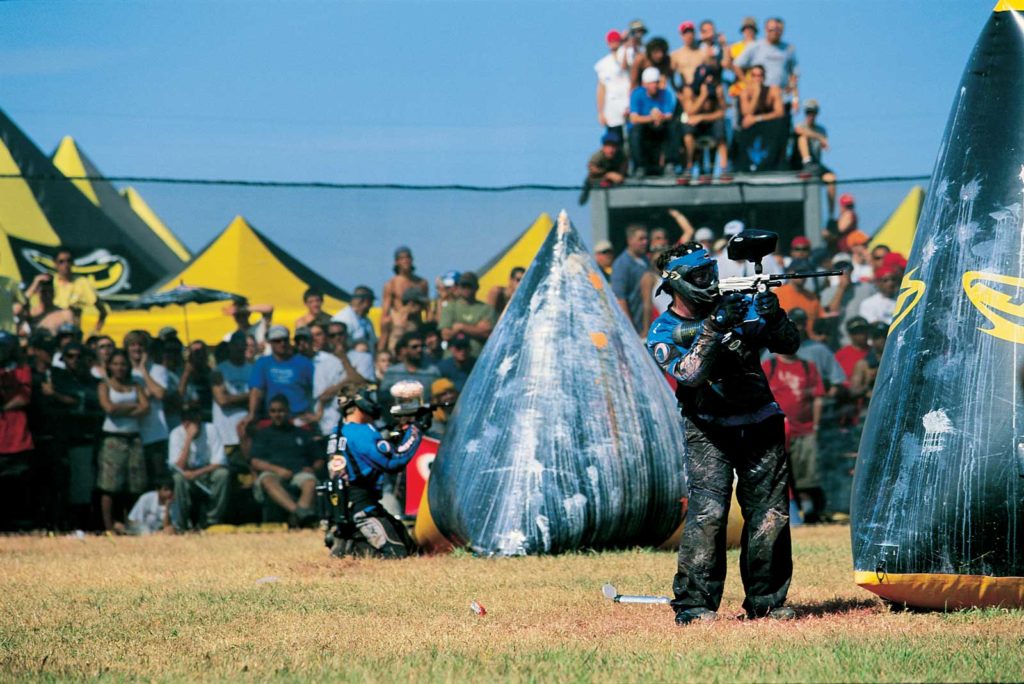
How does one become a mid player? I think it might be by accident. I mean if you are small and fast you should play up front; if you’re big and slow you should play in the back. These guys fit neatly into the middle of those two groups, not as small and fast nor as big and slow. Yet there is more to being a great mid player than simply not making the cut in the front or the back. You have to have those skills that both other positions covet. You have to be able to see the whole field and put together the moves before the other team does. You have to be able to move forward to take over the role of the front player who has been lost or go back out to the corner if a back guy has been illuminated. Players like Oliver, Nicky and Chris could have played any position they wanted on the field. Why did they choose the mid player spot? Because these guys can single-handedly win games. These guys and, for that matter, any other top mid player can literally go out and play well enough to win games all by themselves. That’s not to say that they don’t need a team around them but if their team goes out there and doesn’t make any big mistakes then these guys will figure out how to win the game. Usually, the breakout for any team is the same; the back guys break out laterally and establish along the back of the field while the front guys take as much real estate as they can. Mid players like to find those bunkers that they can break to quickly, get their gun up and hopefully shoot someone on the break. If this happens and it’s the right person, the game could be close to over. A great mid player who shoots his opponent on the break is then able to capitalize on that elimination and make a big move down the field that should secure his team’s victory. Mid players are also crucial to communication within a team. They are often between the front and back players and pass on information.


Front and back players are easily defined by their size speed and skill set. Mid players are defined by their ability to play all the positions on the field well. In addition, they are expected to communicate well and win games. The mid position is probably the hardest to play on the field and they are probably the most important players out there. They win more games and contribute on the field more than any other position.
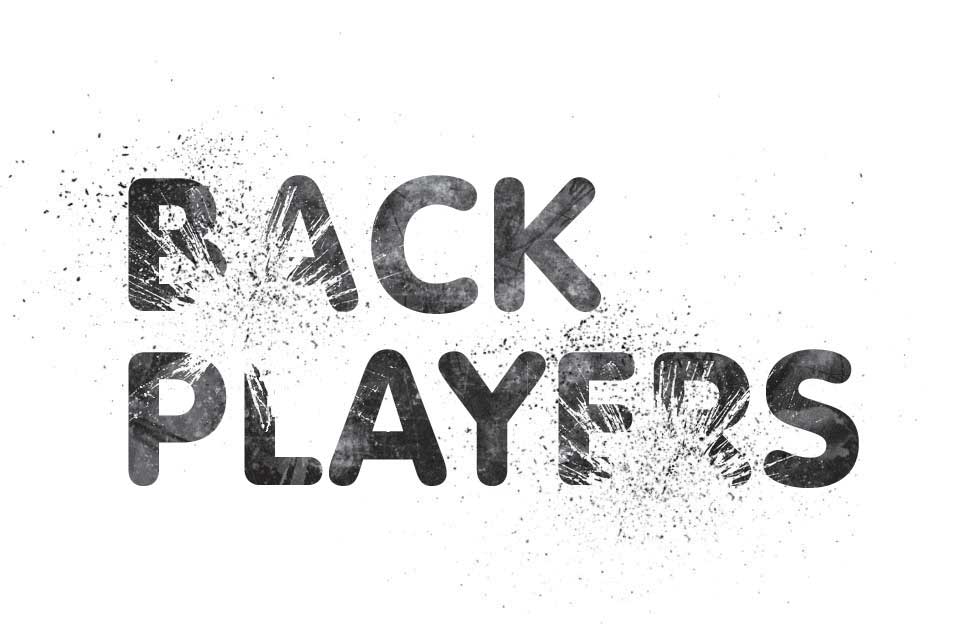
The back player is like the offensive line in professional American football. He is always doing a lot of the work but only really gets noticed when he makes a mistake. The back position is the most cerebral on the field, you are constantly thinking and playing out scenarios in your head. At the same time you’re doing this, of course, people are trying to shoot you and move up the field. I’m not sure what combination of qualities makes a great back player but there are some all the best ones have. They can all shoot well out of the break. This means they will sweetspot well and give their team a chance at an advantage right from the start.
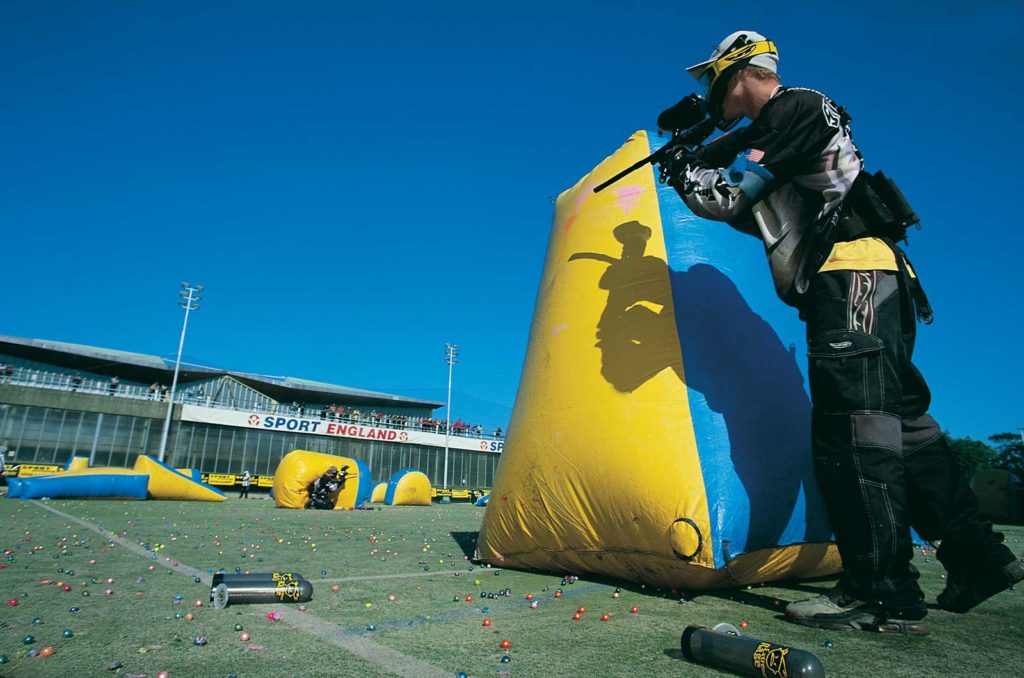
This is harder than it sounds. You have to know where your opponents are going before they get there. You have to guess the route that they are going to take. You have to accurately shoot the spot that they are running to or diving towards. Doing all these things is challenging and at the same time you have to avoid getting shot by the other team. In order, first a back guy sweetspots; then either hits his target or doesn’t and then has to start shutting down the movement of the other team. The best way to do this is by shooting the hell out of the other guys’ bunker. If you target the outside edge over and over and then he runs through it, he is an idiot. That’s not to say that it doesn’t happen- because it does- but the probability of the guy running through the paint without getting hit is very low.
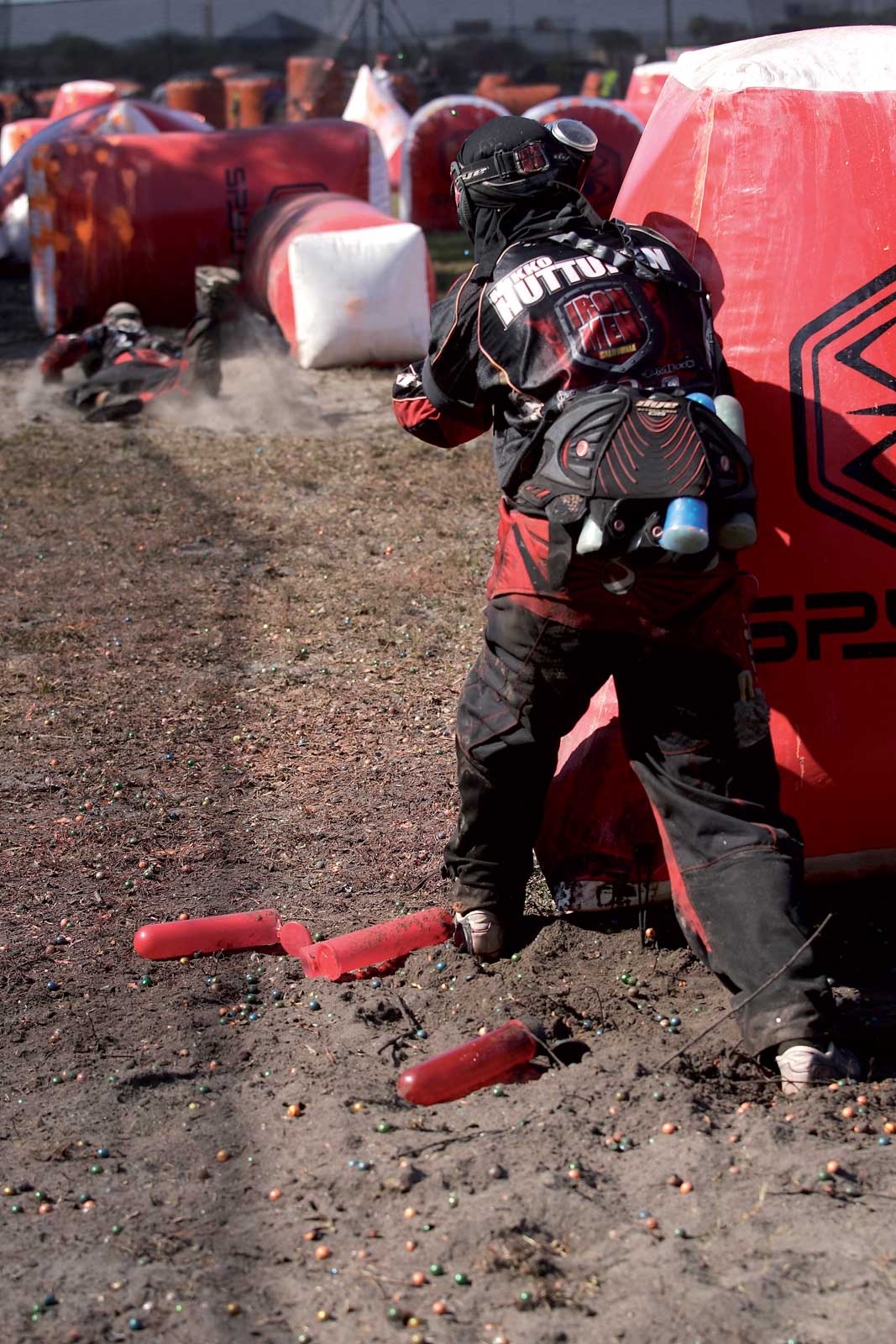

So once you have shot your guy on the break and contained the other team’s most dangerous player, what’s left to do? You then need to communicate to your team your position in the game. How many players did you loose on the break? Did any of the players from the other team make it into their key bunkers? Based on the all the information you gather you then make decisions for those on the front line: whether to attack or to hold back. This decision is based on field position and the number of players on both teams. Once you have made the decision to attack or defend you move your players into position to do your bidding just as you would in a game of chess.

If there is a worst job or position in paintball then there is no question as to what it is. If you do this job, you are never right and, even when you do the best job you can, one team is always going to hate you.
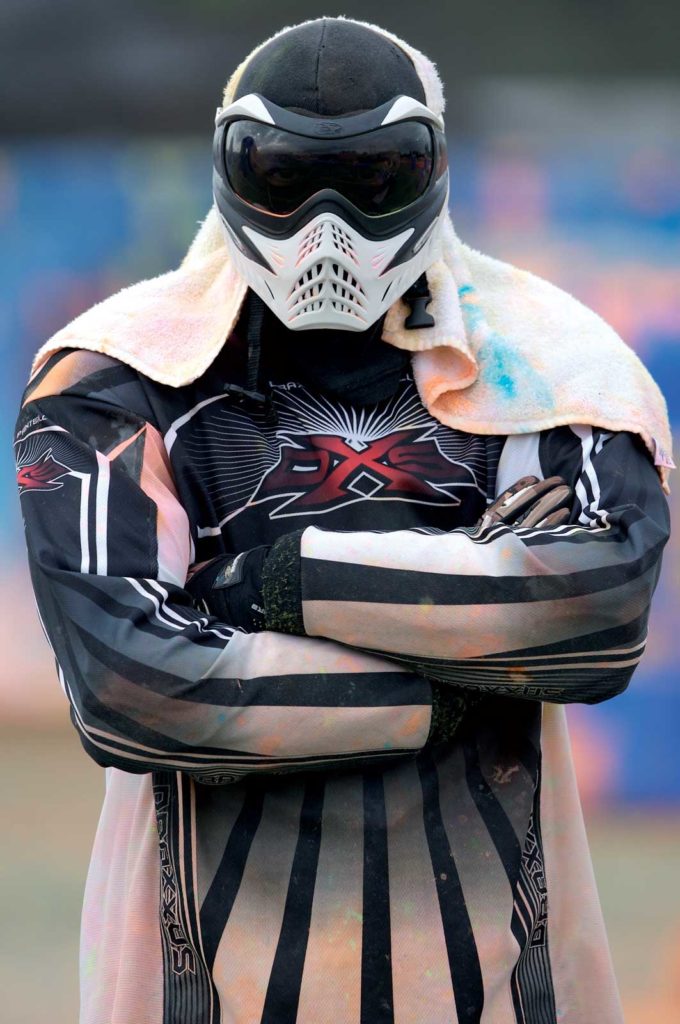
That’s right, I’m talking about the zebras that walk on two feet, the referees. Anyone who has been a referee will tell you with certainty that it’s one of – if not the – worst job in the world. They get shot more than the players; they are always expected to behave perfectly, and the losers always blame them. Back in the old days, the teams used to referee themselves. If it was an LA tournament, one or two LA teams would referee the event. There was always talk about this team or that team helping each other and it might have happened here and there but in reality each team eventually got to referee the other teams. So if you screwed them on the field then they would do the same to you when the event was in their neck of the woods. I think that the major reason that we switched to professional referees was the perception that players refereeing each other just didn’t fly. There was a big push to get paintball on TV and we wanted everything to look like it was much more organized than it actually was.
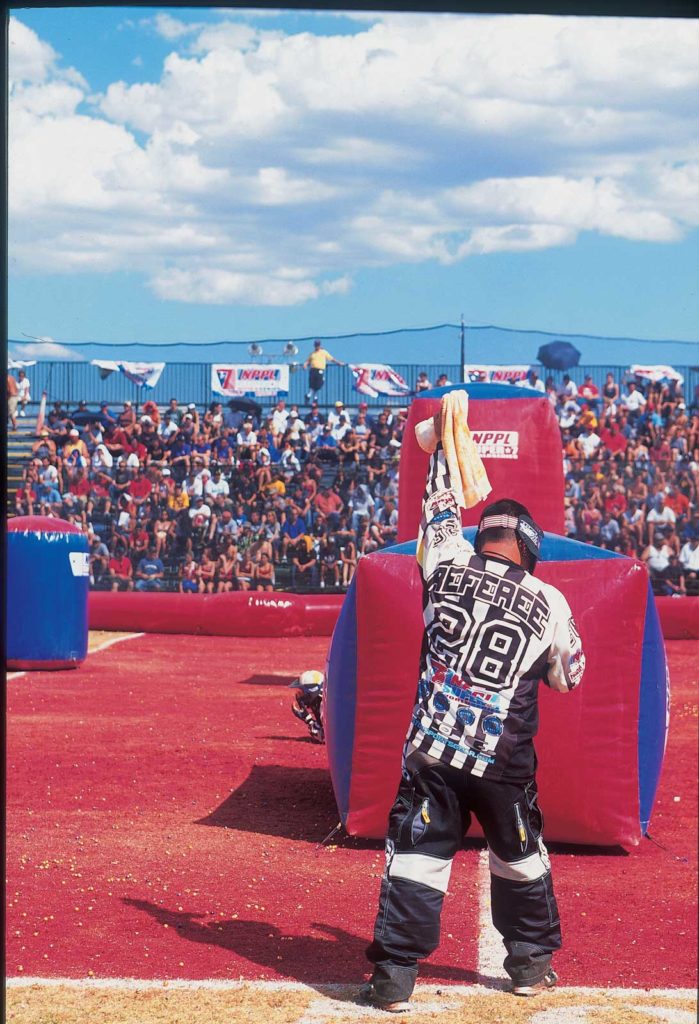
So we brought in a bunch of referees to arbitrate the matches. When they first came in they weren’t really that good but little by little they got there. The best and brightest were in the Paintball Sports Promotion (professional tournament paintball) on the NXL (National X Ball League) fields. Next to them, the best refs had always been the Europeans so occasionally they would be brought over to help out. Little by little, this grew into what we have today; where professional referees arbitrate all major events.
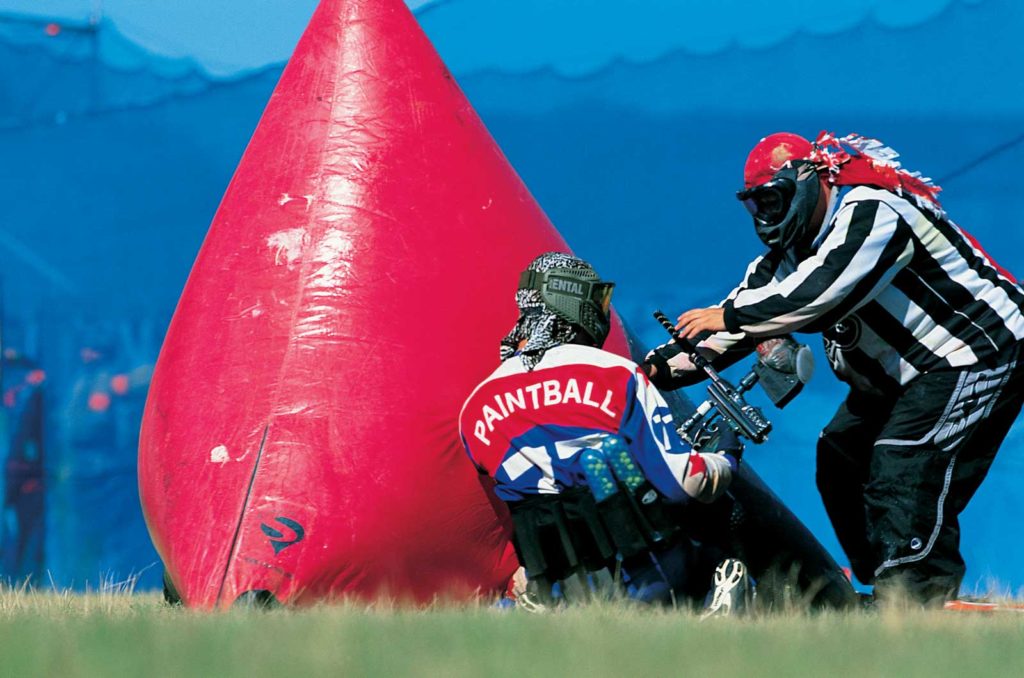
They do a great job, or at least the best job that they can do under the circumstances.
I think the next step in the evolution of refs is to start bringing in some of the retired pros to join the ranks of the pro refs. These guys work long hours and for little to no pay so you can see why retired pros haven’t been fighting to get involved. However, we owe it to the sport to give something back and to help a bad situation get better. This is the one constant complaint at every tournament so let’s all get together and try to fix it.




Moving is really what paintball is all about. There are three major components to paintball; they are shooting, communicating and moving. The more you move and the more effective you are at moving, the better you play paintball. Gun fighting takes a while to master and communicating also takes time to get the hang of, but we can all move. There are two sides to moving, these are moving as a team player and preventing your opponents from moving. So you move or transit up the field to try and gain an advantage on your opponents. The closer you are to them or the further you are on their side of the field, the more angles you can exploit. Having a number of angles to use is where your advantage lies. Bunkers are often set upon that have great angles on many of the others. These are the key bunkers on the field. You have to move to these bunkers either on the break or as the game progresses. Of course, just as you’re trying to move up the field to gain an advantage so are the bad guys; so some of your teammates are trying to keep them from moving whilst you’re progressing to strategic points.
The difference between a good paintball player and a great paintball player is the same as the difference between an average and a great chess player. The more moves ahead you can think of in a fraction of a second, the better player you are. You see paintballers making big moves all the time but once they have made the move, they stagger around in a circle wondering what to do or where to go next. Great paintball players know exactly where they are going and what they are doing and they don’t need anyone to instruct them or much time to figure it out. Big moves in paintball are the coolest thing to watch: one guy running down the field shooting at two or three guys on the run.They don’t happen all the time because they are really hard to pull off, but when they do and it all goes right, everyone stops and is caught in the moment, bewildered by what they just saw. They wonder if they could do it or if it could be done again. Did all the stars line up just right to make this happen or is he really that good? Sometimes, the players themselves don’t even know what they pulled off, they just made a move and then things started to happen. Those are the truly gifted among us, the instinctive players that move down the field at will, effortlessly it seems.
When the sport was in its infant stages, people moved down the field but they did so on their own. They just put a guy in and made the move. Nowadays, the fields are smaller and the guns are faster which makes it much more of a team sport. You have to work with your teammates to eliminate the opposing players and then make your moves. This is much harder to do but the rewards are often much greater. If you make the right move and get to the right spot, you look out and all you see are the backs of the players on the other team and that is just about as good as it gets.

Moving is really what paintball is all about. There are three major components to paintball; they are shooting, communicating and moving. The more you move and the more effective you are at moving, the better you play paintball. Gun fighting takes a while to master and communicating also takes time to get the hang of, but we can all move. There are two sides to moving, these are moving as a team player and preventing your opponents from moving. So you move or transit up the field to try and gain an advantage on your opponents. The closer you are to them or the further you are on their side of the field, the more angles you can exploit. Having a number of angles to use is where your advantage lies. Bunkers are often set upon that have great angles on many of the others. These are the key bunkers on the field. You have to move to these bunkers either on the break or as the game progresses. Of course, just as you’re trying to move up the field to gain an advantage so are the bad guys; so some of your teammates are trying to keep them from moving whilst you’re progressing to strategic points.
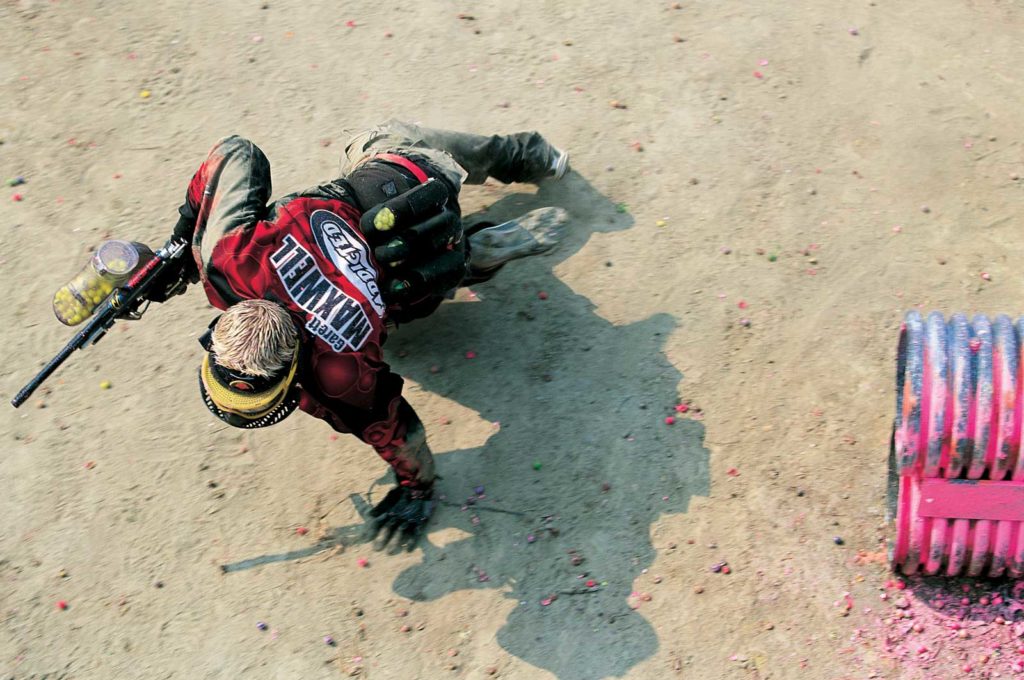
The difference between a good paintball player and a great paintball player is the same as the difference between an average and a great chess player. The more moves ahead you can think of in a fraction of a second, the better player you are. You see paintballers making big moves all the time but once they have made the move, they stagger around in a circle wondering what to do or where to go next. Great paintball players know exactly where they are going and what they are doing and they don’t need anyone to instruct them or much time to figure it out. Big moves in paintball are the coolest thing to watch: one guy running down the field shooting at two or three guys on the run.They don’t happen all the time because they are really hard to pull off, but when they do and it all goes right, everyone stops and is caught in the moment, bewildered by what they just saw. They wonder if they could do it or if it could be done again. Did all the stars line up just right to make this happen or is he really that good? Sometimes, the players themselves don’t even know what they pulled off, they just made a move and then things started to happen. Those are the truly gifted among us, the instinctive players that move down the field at will, effortlessly it seems.
When the sport was in its infant stages, people moved down the field but they did so on their own. They just put a guy in and made the move.




Nowadays, the fields are smaller and the guns are faster which makes it much more of a team sport. You have to work with your teammates to eliminate the opposing players and then make your moves. This is much harder to do but the rewards are often much greater. If you make the right move and get to the right spot, you look out and all you see are the backs of the players on the other team and that is just about as good as it gets.

Back when we played in the woods, the only snakes that we had to worry about were the type that bite you. One of the skills that players used out there was the ability to get down low and sneak from one spot to another. We called it crawling. This allowed us to get a better angle on the guys across the field or to get closer to a player that we wanted to eliminate.
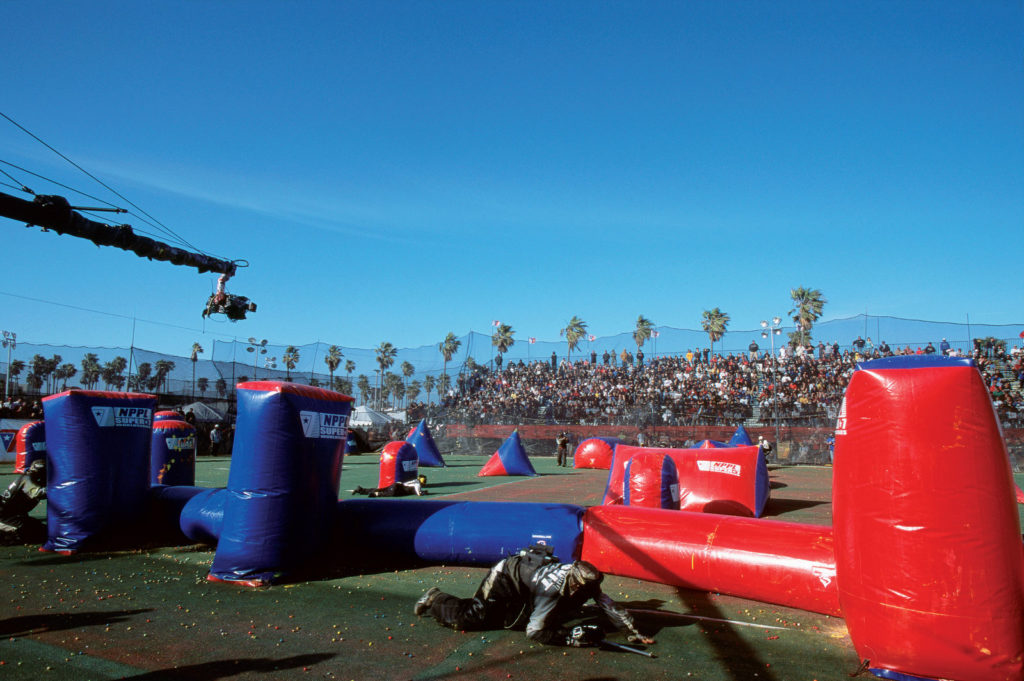
The first real ‘snakes’ appeared when we started playing on the hyper ball fields. These were large fields that used black corrugated pipes as bunkers.The snake bunker would be long, sometimes almost as long as the field. The snake would have small legs coming off it that players would use to hide behind as they worked their way up the field.
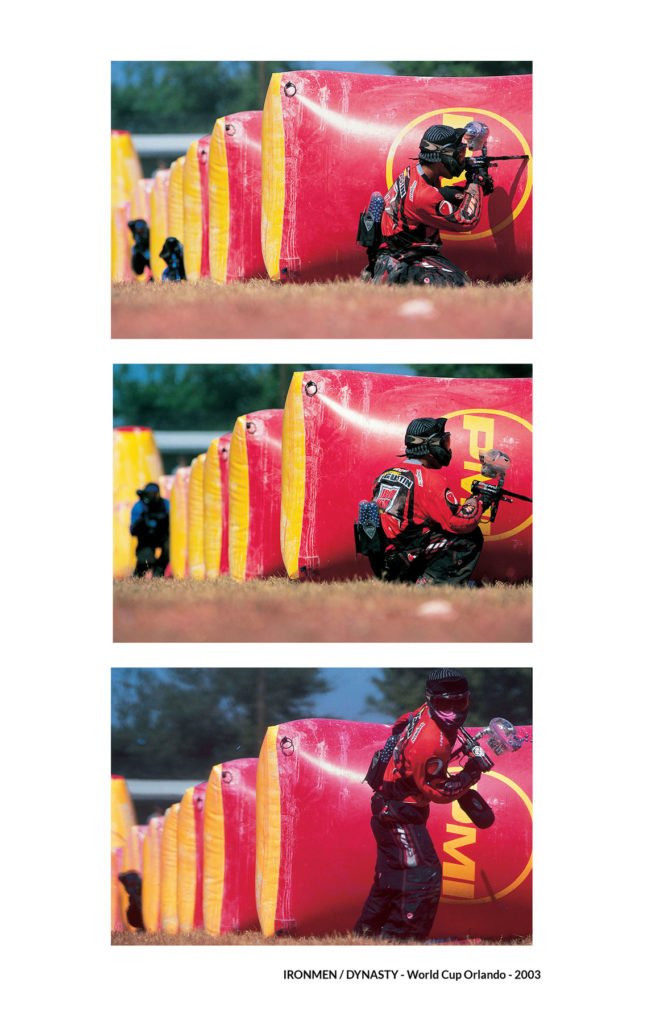
When Sup Air started to make air ball fields, the snake really took off. The first ones actually looked like snakes – only much bigger – the snakes were forty feet long with a tail and a tongue. They didn’t have legs like the hyper ball field ones so they made up for it by having bends. Players would use the angles in the snake to block the opponents’ shots as they tried to work their way down the field. The new snakes are on almost every field that we play in one form or another. They are the power bunkers on the filed. In many games and on most fields, the snake wins the game so you have to win the snake battle to win the match. The new ones come in many shapes and sizes but they are almost all long and low.In order to play the snake, you need to be small and fast, the smaller and faster the better. Not only is the snake the most strategic bunker on the field, it’s also the most recognizable. It’s almost always on the tape (e.g. the very edge) so on one side of the field or the other. It’s usually long, but not always; some consist of a few short snakes with spaces between them.





The thing that most people like about the snake is the action. There is no other spot on the field that has more action. The snake is a fast paced and action filled spot on the field with many games won and lost in it and because of it. Sure there are other bunkers but no other like the snake. It’s in a class of its own. If you want to watch the real action in any game, watch the snake side of the field. If you want to play a game, get good and playing the snake and you’ll do well. .

Snap shooting is best described as the ability to break cover for the briefest of moments and to shoot one ball very accurately at you opponent and then get back to cover before your opponent can mark you. Although the task is simple, mastering it can take a lifetime and some of the best players in the world are unbelievably good at it.
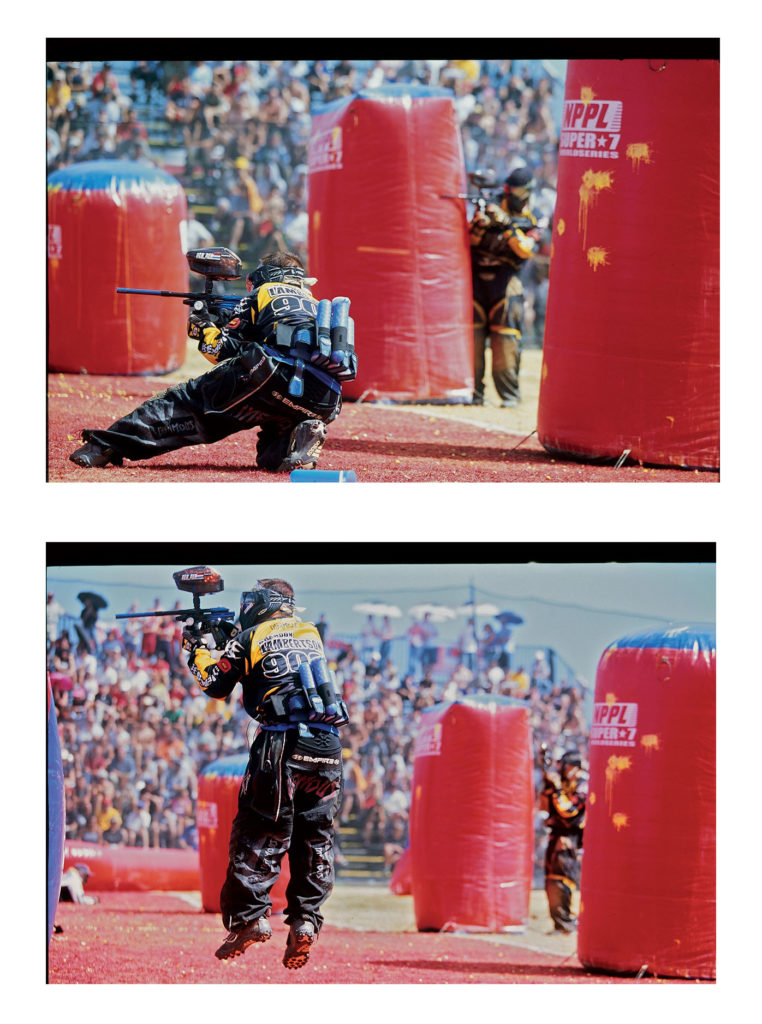
They can have an opponent right in front of them already gunning at them and in a fraction of a second they can snap out, shot their opponent and get back behind cover without being marked. Although this is a simple task and the mechanics aren’t all that difficult, to be able to do it well, over and over again, takes a lot of work. This is one of the best skills to have as a paintball player because it is what the sport is all about. You are one on one against another opponent who has the advantage and you figure out a way to beat them. I highly recommend you spend time working on, and perfecting, this skill if you want to be a good paintball player. You can never be too good a gun fighter- and snap shooting is your bread and butter.
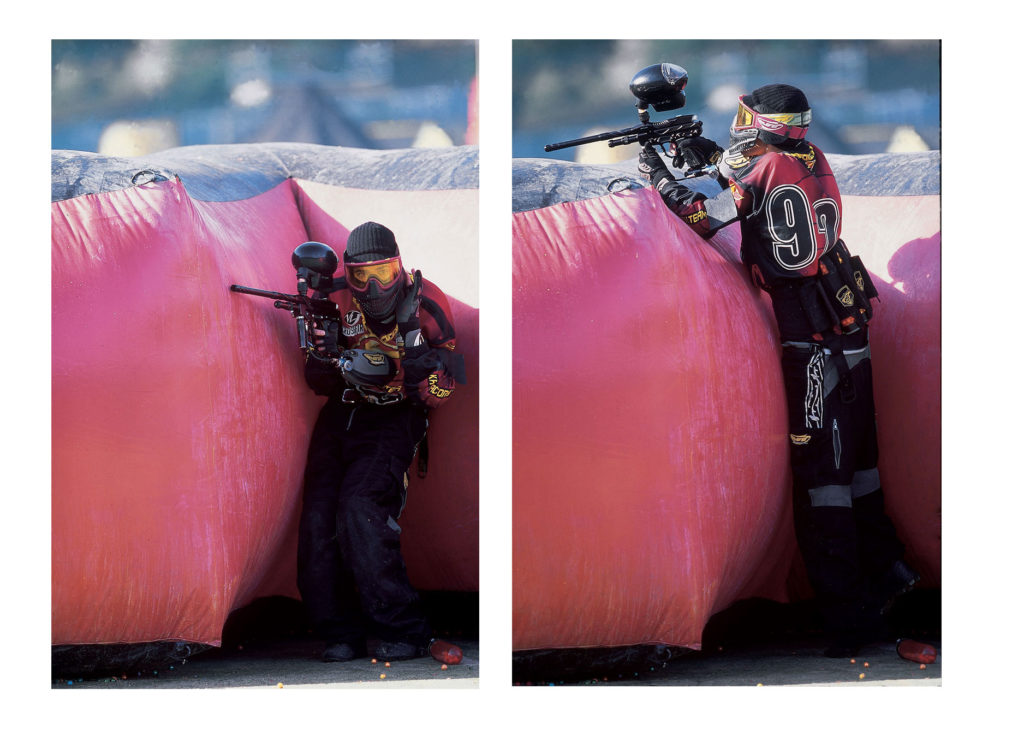
Snap fighting has always been a big part of paintball although some people are forgetting about the importance of it now, with the advent of the fully automatic guns. I can tell you the ones who aren’t forgetting about it are the pump players that are still out there. I watched a pump tournament recently and these guys were on fire with their snap shooting. Watching them play was like watching a snap shooting tournament, it was great. They would come out of cover and shoot one straight ball and get back to cover in one fluid movement.


Learning how to be a good snap shooter is easy and you don’t have to use a lot of paint because you’re only shooting one ball at a time. This drill is best done against someone who is better than you, but try to work on going back and forth in and out of your bunker without getting shot while your partner does the same thing. At first, you can do this from a good distance just to get the feel of it. Once you get better at it, you get closer so that you can hit what you’re shooting at and vice versa. This should be practiced as much as possible and once you get good, your game will be much stronger and you will be able to work on your other paintballing skills. Another way to get good at this, which is probably faster, is to do a clinic with a pro. Any pro out there will do, they are going to be better at it than you and will help you get past some of the most common mistakes. People tend to lead with their elbows and step out with their feet. People also like to snap out from the same spot all the time. A pro will help you work on all of these things and you will grasp in a day or two what would have taken you a year to figure out on your own.

Loading paintballs is way harder then it looks. When the sport was young, loading paintballs wasn’t even considered a skill. When you shot a lot less paint and there was no such thing as a line of paint, there was no need to load fast without spilling or dropping your line of paint. Now it is essential and although it’s not really hard to do, it gets harder when people are trying to shoot you and the game is on the line.

Most people can’t even handle playing paintball at the most competitive levels. Add to that trying to take something out of a pocket on your back, that’s tough; and that is only the half of it, once you get it off your back, you need to open it and then without getting shot, bring it up over your head and drop it gently on top of your hopper.





Again, you have to do all this while you’re shooting your gun and trying not to get shot. I can’t even imagine how much paint has been wasted by guys trying to load their hoppers and dropping a whole pod on the ground. It’s one of the funniest things that you see in videos or in games; a guy gets to the pinnacle of the game and he uses his last three pods to get a total of twenty paintballs into his gun. At this point, out of complete frustration over not being able to perform the simplest of tasks, he gets up and runs down the field leaving the game to chance.
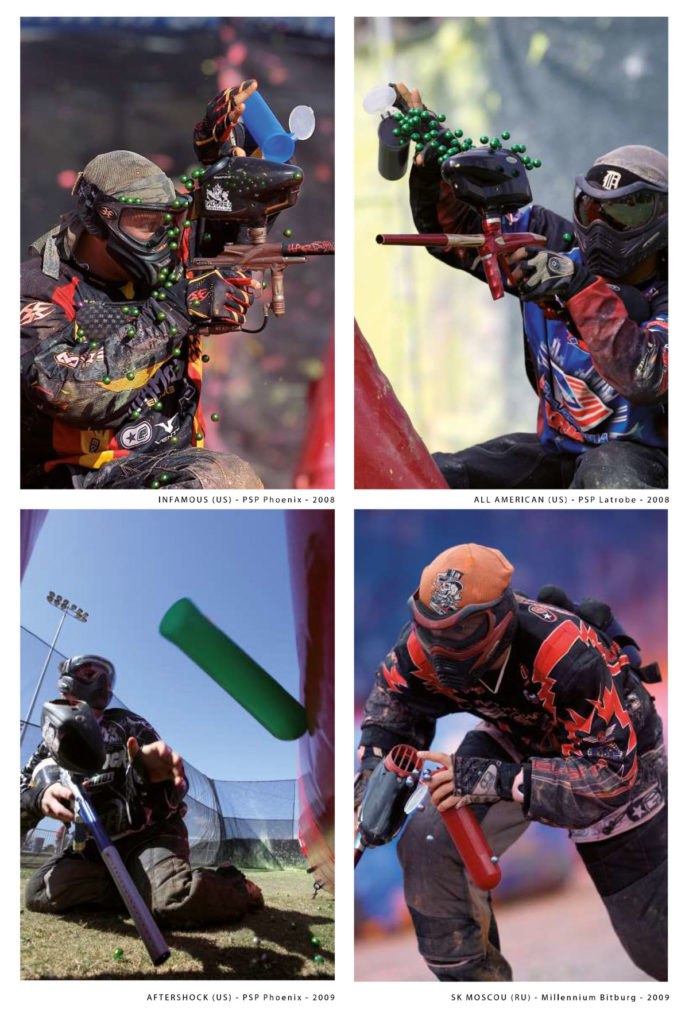
One invention that has really helped players in this area is the speed feed. The speed feed is a lid that goes on the hopper with plastic fingers that allows the paint to go in but not fall out. With a speed feed on your gun you don’t have to open and close your lids. I think most of us that play have been loading and shot in the lid but those days are over now. The only real draw back to the speed feed is rain. Having a big open hole on the top of your hoppers is great for getting paint in there but bad for keeping the rain out.

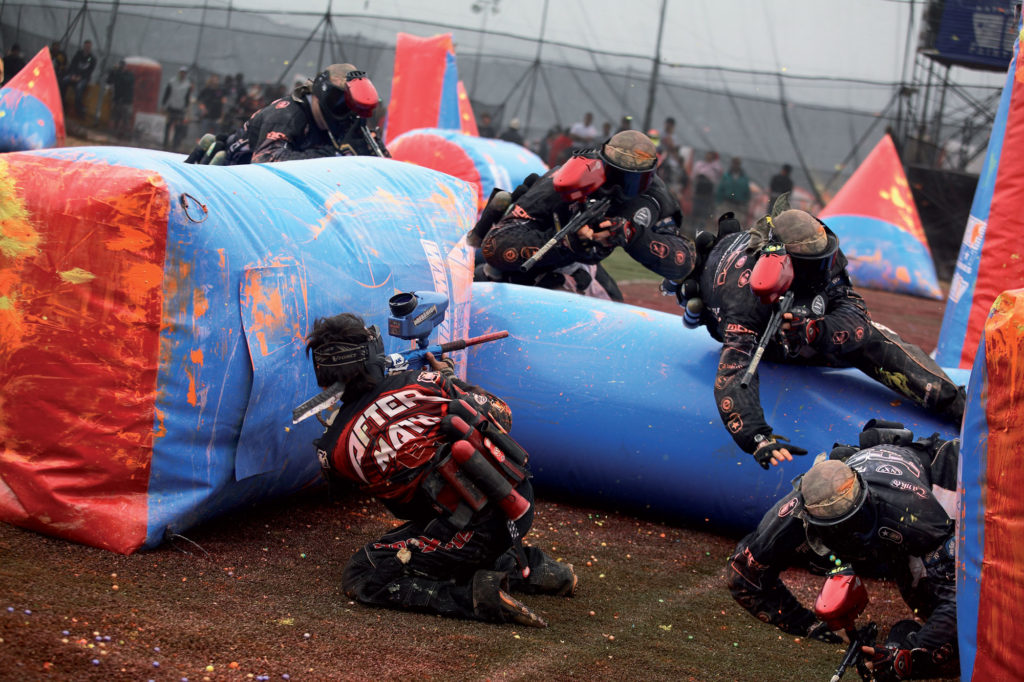
This is the slam-dunk of paintball. This is spiking the (American) football in the end zone.
The coolest move in paintball bar none. Bunkering is when you run up to your opponent and shoot him at point blank range. It’s very demoralizing for the opponent, you got close enough to touch him without him knowing and then you blasted him.









There used to be a lot more bunkering but with one of the leagues letting people yell from the sidelines, bunkering has been diminished somewhat. I think that the other thing that cut back bunkering is the appearance of super fast guns.
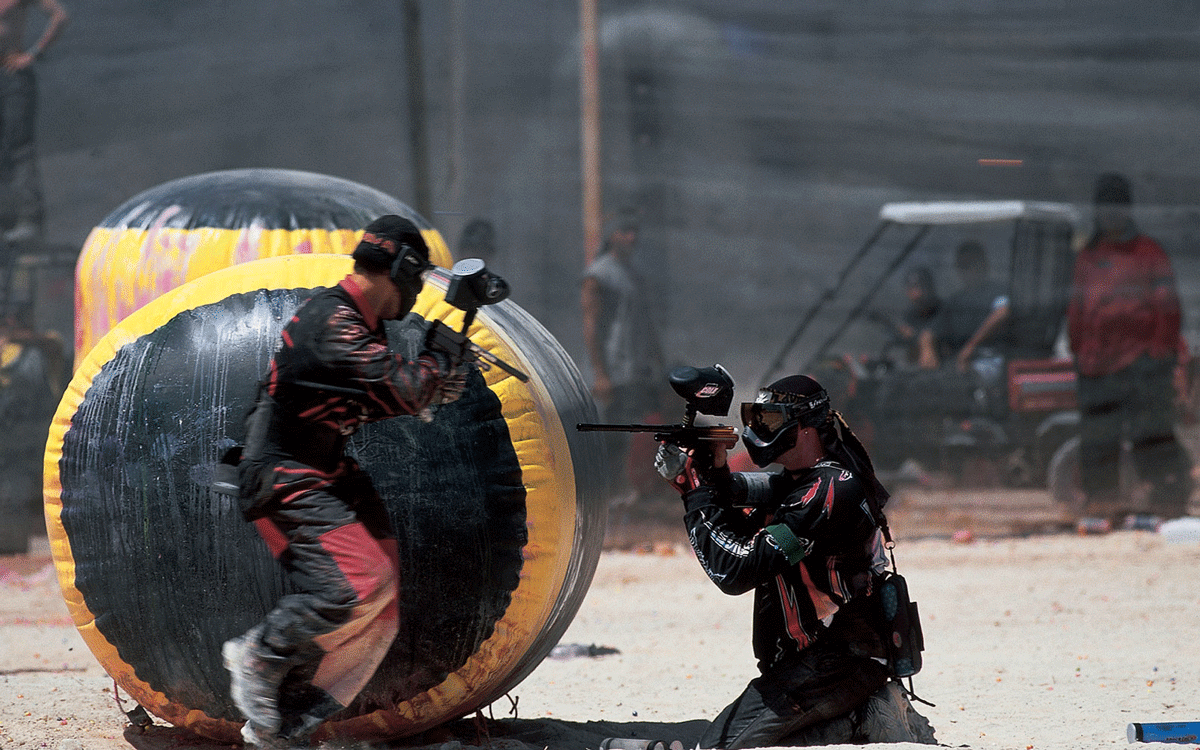
It’s much harder to bunker someone when the guy behind him has a laser beam. The one spot where there is still a lot of bunkering is the snake and that’s great. Paintballs hurt and the closer you are the more they hurt so point blank really hurts. Watching a really good player set up, move and then go ‘bunker’ someone is as cool as it gets. To ‘bunker’ someone, you have to be of a somewhat aggressive nature; you have to be willing to take the big risk for the big reward. The truly great players can ‘bunker’ more than one player, practically winning or breaking open the game with one move.








In order to ‘bunker’ someone cleanly, which means you shoot him and don’t get shot, a lot of things have to happen just right. First, you have to know where the players around this player are and what they are doing. You have to know which way the player you’re going to bunker is looking. Then you have to work it all out in your head.
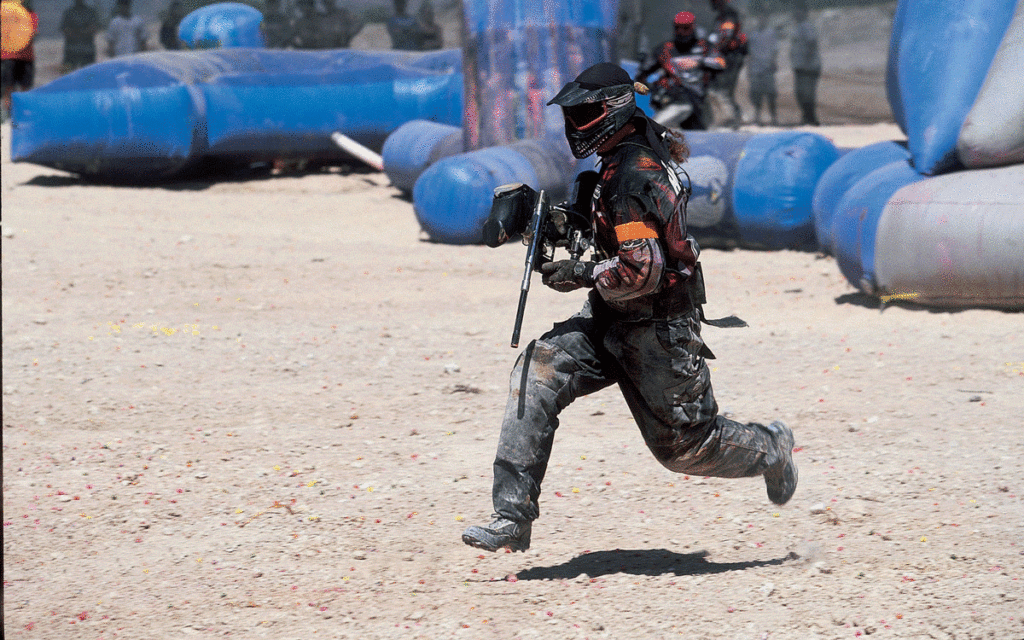
What you’re working out is who can shoot me if I try and go get this guy. Once you figure out who can shot you then you try to get the guys on your team to put the opposing players in. Unfortunately, good players know when you’re setting up to go get their guy so they try to prevent you from doing so. If you’re good enough to figure all of this out and your players are helping you, you get ready to make your move.
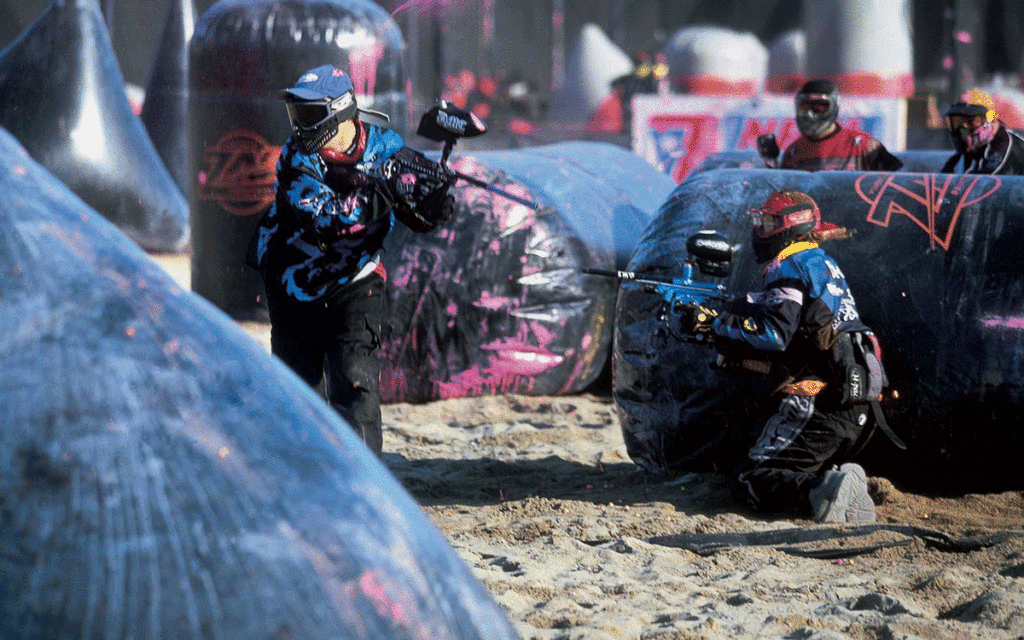
Even with all of the planning and help there is no guarantee that you are going to get your guy. On the one hand, you may step out and get smashed and when you do that you look like an idiot.



On the other hand, when all the stars line up and everything is going just right, you make your move and you’re a hero. Maybe only to yourself and to your team but there is no better feeling on the field.
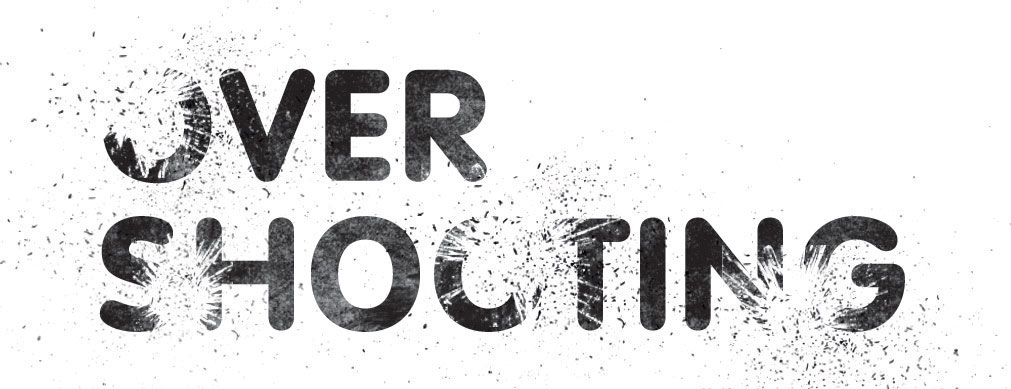
Overshooting is when a player gets hit with multiple paintballs after the first ball has already broken.
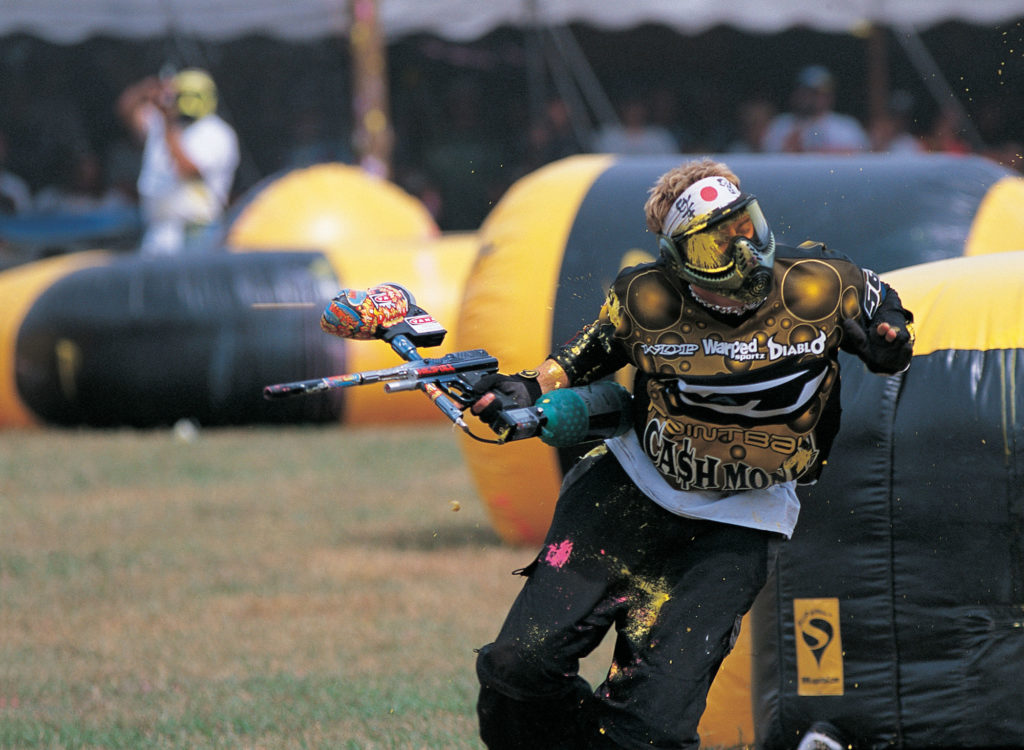
Once the first ball breaks on you, you are eliminated so there is no need to be shot again. That is unless the first ball bounced or slid off on you and didn’t break. Overshooting has changed over the years. Back when players used one-shot pumps, two or three balls were considered overshooting. Then people started shooting semi automatics and the two or three balls became five balls. Just like that, the arms race had started. Some genius- who was also a paintball manufacturer- decided that we should shoot fully-automatic guns. Now, you get hit with ten balls, maybe more. Looking back, I think that this was one of the biggest mistakes that our sport made. We scared off many potential new players with our super fast guns and the inevitable overshooting that came with them.
Now overshooting is going to happen even under the best of circumstances, it’s just part of the game, especially if you’re competing. Quite often when you’re shooting at an opponent, you don’t see them. You’re shooting where they are going or where you think they might pop out. With the new faster guns there is more paint in the air. When there is more paint in the air, people get shot more. Think about it like a water hose, you spray someone with a hose and as soon as you hit them you turn the hose away, what happens? What tends to happen is that all that water keeps moving forward and splashes them no matter where the hose is pointed. The same thing happens with paintballs.





There is also a different kind of overshooting, one that is all too familiar. It’s the kind that happens on purpose. You might think a guy cheated or maybe you just don’t like him so you shoot him and give him a couple extra to show him how you feel. Of course, he doesn’t appreciate this so the next time you play, he returns the favor and so on. If this becomes too obvious at a tournament, they will penalize the guilty player but it’s a tough penalty to call because there is always a lot of paint in the air.
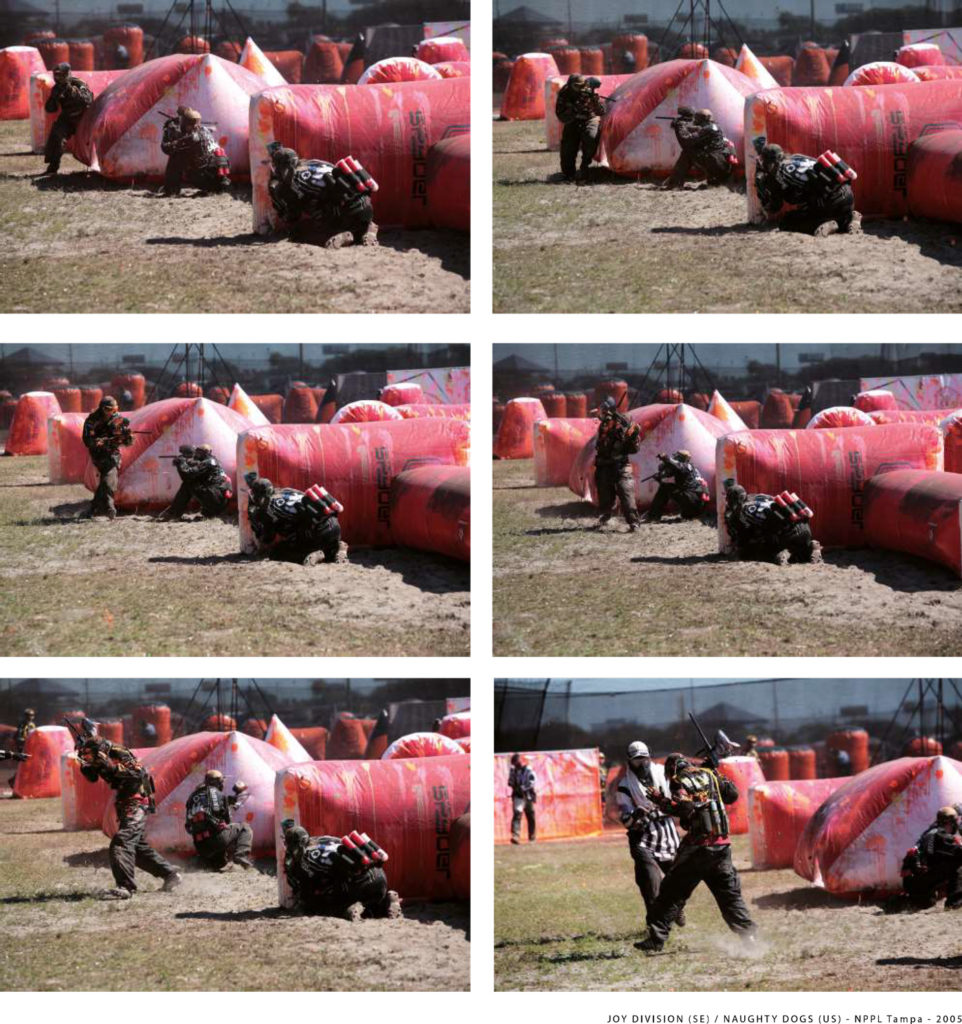
Every once in a while someone will get a penalty for it and everyone will back off the extra bullets a little bit. The best thing to do is to just not get into the game of overshooting. You will get overshot at some point, it happens, just try not to make a big deal out of it and move on. If it gets too bad, then do what you have to do but be careful, there are guys out there that play this game very well, and you don’t want to be on the losing side of an overshooting war.
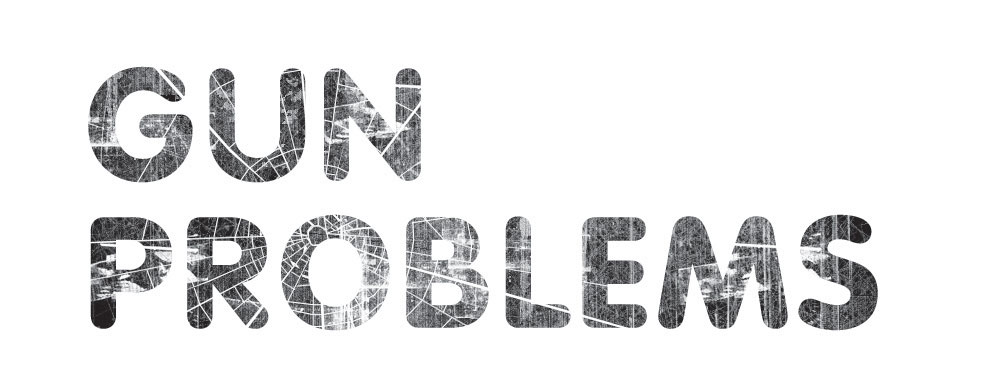
You might be the best player in the world but if your gun doesn’t work then neither do you. Paintball, like any other sport, relies on equipment.
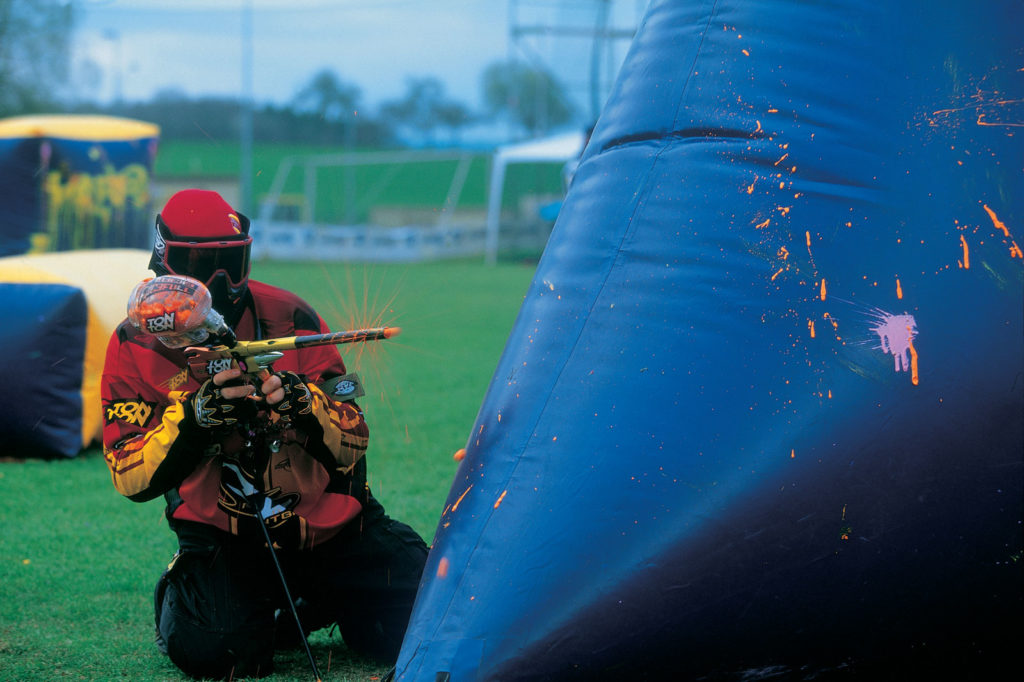
That’s not to say that you need the best equipment to be the best player, but it doesn’t hurt. Players spend tons of time getting their gear just right. You have to because you rely on it so heavily. First, you have to find out what gear works best for you. Everyone is different and has their own taste so what works for one might not for another. Once you have figured out what equipment works best for you then you have to get it working as well as you can. The catch is that when you set up your equipment and you are getting the most out of it, you tend to wear it out. The more you use your gear, the better it works, until it doesn’t. There is no worse feeling than being in the middle of a big game and your gun breaks or your goggles fog. There is also a strange phenomenon that occurs when this happens, everyone exposes themselves to you and you could have had the game of your life. Almost every time my gear has broken down on me in a big game, I could have easily won the game if only I had had my gear running.





Gear breaks down for all kinds of reasons and all of your gear can and will fail at some point. Even if you have a great tech and you take really good care of your gear, it’s going to fail and, when it does, you are screwed. The best thing that you can do is to try and help your team by not letting the other team know that your gun is down and by drawing as many guns as you can. This isn’t always easy when you can’t really do much but it’s the only thing you can do to help. Sometimes your equipment is only partially down and if that’s the case then you have a chance, a small one, but that’s better than nothing.
Depending on what’s wrong, you might be able to fix it on the field. Maybe you only broke paint in your gun so you can clean it out. Hoppers break all the time and if yours does you’re in trouble but at least you can hand load a ball or two at a time. Maybe it’s your goggles and they have fogged up so badly you cant see anything so you rub off the lenses and make a move before they fog again. The point is just because your gear is down doesn’t mean you have to be. In the long run, the better you take care of your gear the better it will take care of you but it”s still going to fail at some point so make the best of it. Oh, and always be nice to the gun techs, your life is in their hands.
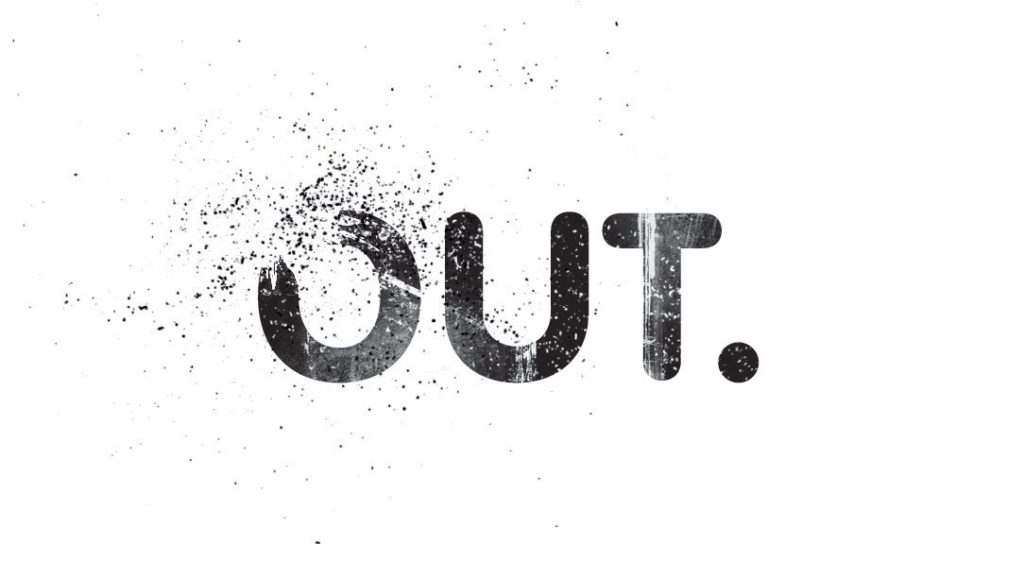
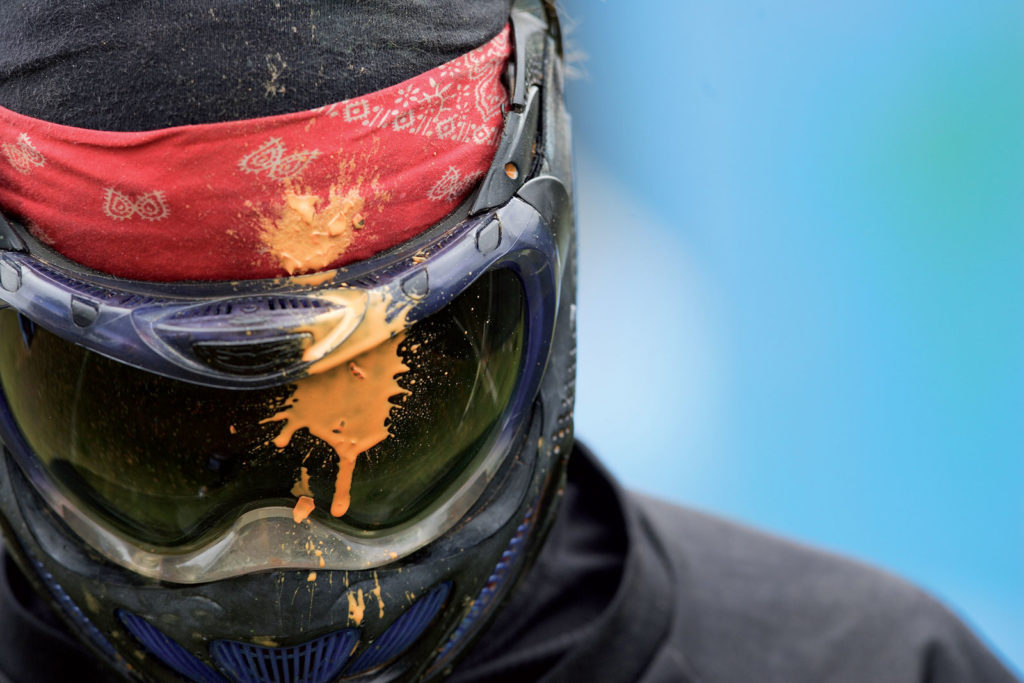
The worst thing that can happen to you in a game of paintball is getting put out! The only thing that you can hope to do is to go out in a blaze of glory. No matter how fast you are or how clever, sooner or later, you are going to be out. At some point, a ball will come out of nowhere and hit you and if it breaks then you are out. Maybe you’ll be lucky and the ball will bounce off of you and not break this time but the next ball will be on its way. So you might as well get used to it, you might as well get used to being out. Sometimes, when it happens, you don’t even feel it when you get hit. You might be playing your game having a great time and another player or a referee will lean over and say ‘you are out’. Other times, it will hurt so much that you don’t even care about the game anymore; all you’re thinking about is the sting from the last shot.





I guess there are good ways out and bad ways to get shot out. A great way is running through the field trying to shoot as many guys as you can. For some reason, when you do that, even if you get shot to pieces, it doesn’t hurt much. The feeling that you shot a couple of guys before you went down is enough to mask the sting from all the hits you took. Other times, that just isn’t the case. For instance, when you’re on the other end of a guy making a big move and shooting you in the back. I think it’s the shock of not knowing that it’s coming and then- boom – fire on our back. Sometimes, you get shot out as soon as the game starts from an unknown source and that is frustrating. If you get shot early and you don’t know who shot you; it’s tough because you don’t know what to do differently in the next game.
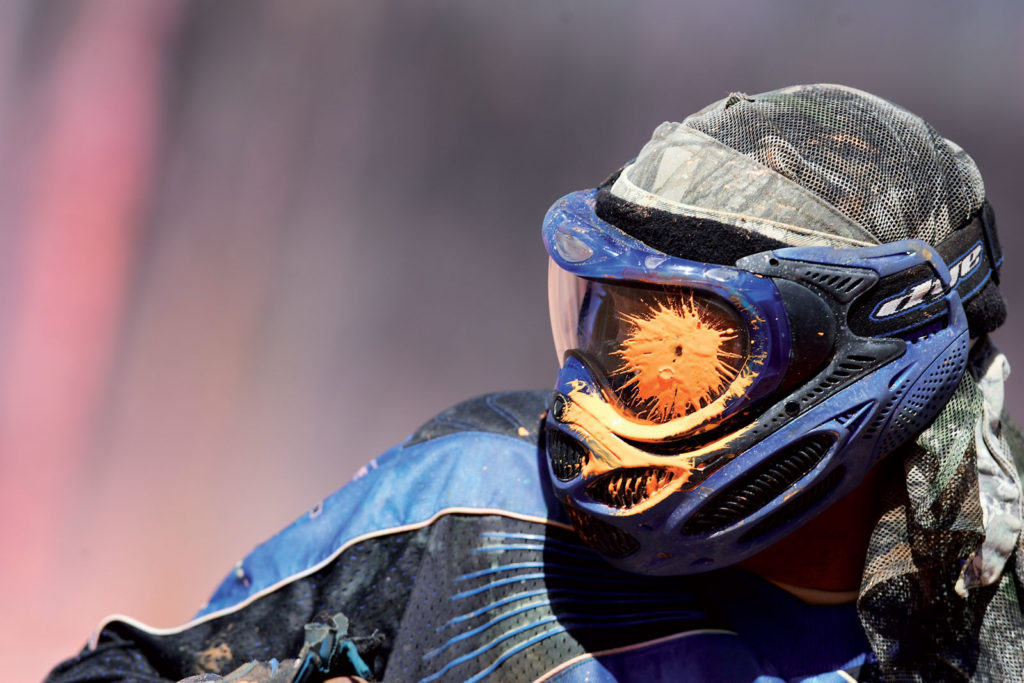
The only thing worse than the physical pain of getting shot out, is the mental anguish. No one likes to lose. In paintball, when you get shot out, you lose. This does not mean that your team will not win, but not with you on the field. Occasionally, you’re one of the lucky ones that get to make a big move and win the game for the team but those events are few and far between. Most of us get shot out trying to stop other guys from making big moves or trying to make one ourselves. Paintball is a blast, it the most fun thing that I have ever done and I do it as much as I can, but if you’re going to play paintball, you’re going to get shot out. The sooner you can come to terms with the fact that you are going to get shot every once in a while, the better a time you’ll have playing this sport.

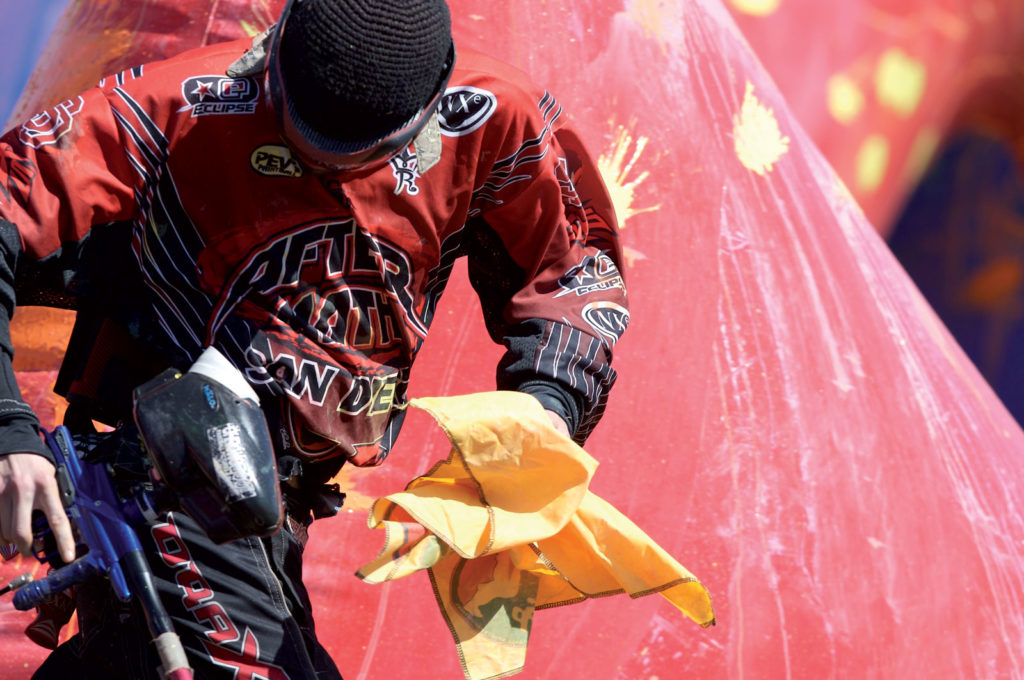
There is no better or no worse feeling than someone grabbing the flag depending on where you’re standing. There are many different paintball games. They are mostly based on how many players are involved and the environment the game is being played in. The one thing that almost all have in common is that they play ‘capture the flag’. Your flag represents your team, your will and your spirit. To break through the enemy lines and take that away from them makes you feel like a million bucks.




Of course sometimes it is you and your team who watch some ‘bad guy’ come into your house and take your flag. There are different games, in some the flag is in the middle of the field, in others it’s at the other team’s base but it doesn’t matter where it is, you have to get theirs and defend yours. This is the very principle of paintball: attack and defend the flag. Neither is more- or less – important. The glory guys want to attack and the strategic guys want to defend. In the end, you have to do both and the team that does that, wins. .*
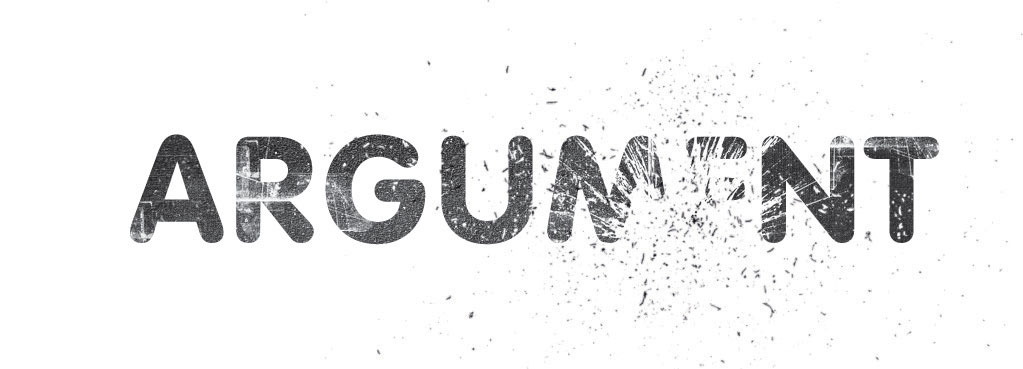
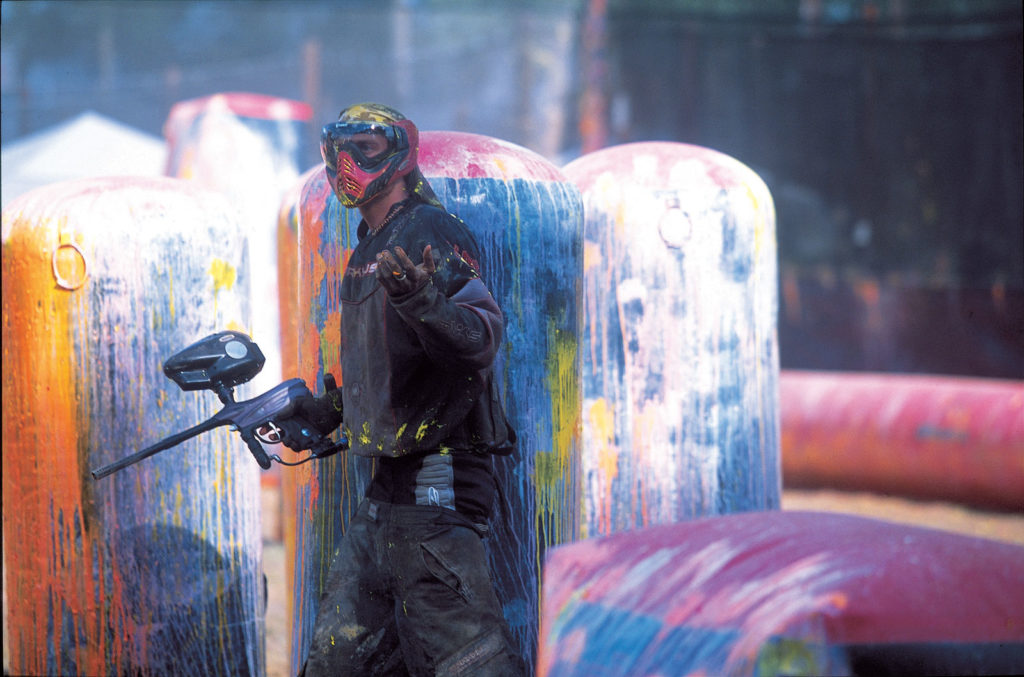
Man! This happens way too much at paintball tournaments. If the teams and players understood one simple fact, it wouldn’t be that way. It’s not about what happened on the field or who did what or didn’t do what. What matters and the only thing that matters is what the judge saw. That is what it’s all about; we see things all the time from the sideline but if the referee doesn’t see it then it didn’t really happen. Even though we know this, we march out onto the field to argue with the refs and try to convince them that they saw what we saw. What we are really trying to do is to get one of the other refs, who might have witnessed the same thing as us, to come over and help argue our case. All in all, the refs do a good job but it’s a tough job and you can’t see everything so they can’t be expected to. What they are expected to do is to be fair and do their best to enforce the rules when and where they can. Of course, in the heat of the argument, we don’t care how hard their job is or whether or not they are human; we want what we want and we want it right now. In the entire history of paintball, I can only think of one game that was ever replayed and that was the Kansas City debacle with the Ironmen and Impact. What a bad joke that was! It was no one’s fault and everyone’s fault that that was ever allowed to happen. There was some confusion on the field and it was late so they decided to replay the game at the next event. This was, as far as I can remember, the only game that was overturned and it probably won’t ever happen again.




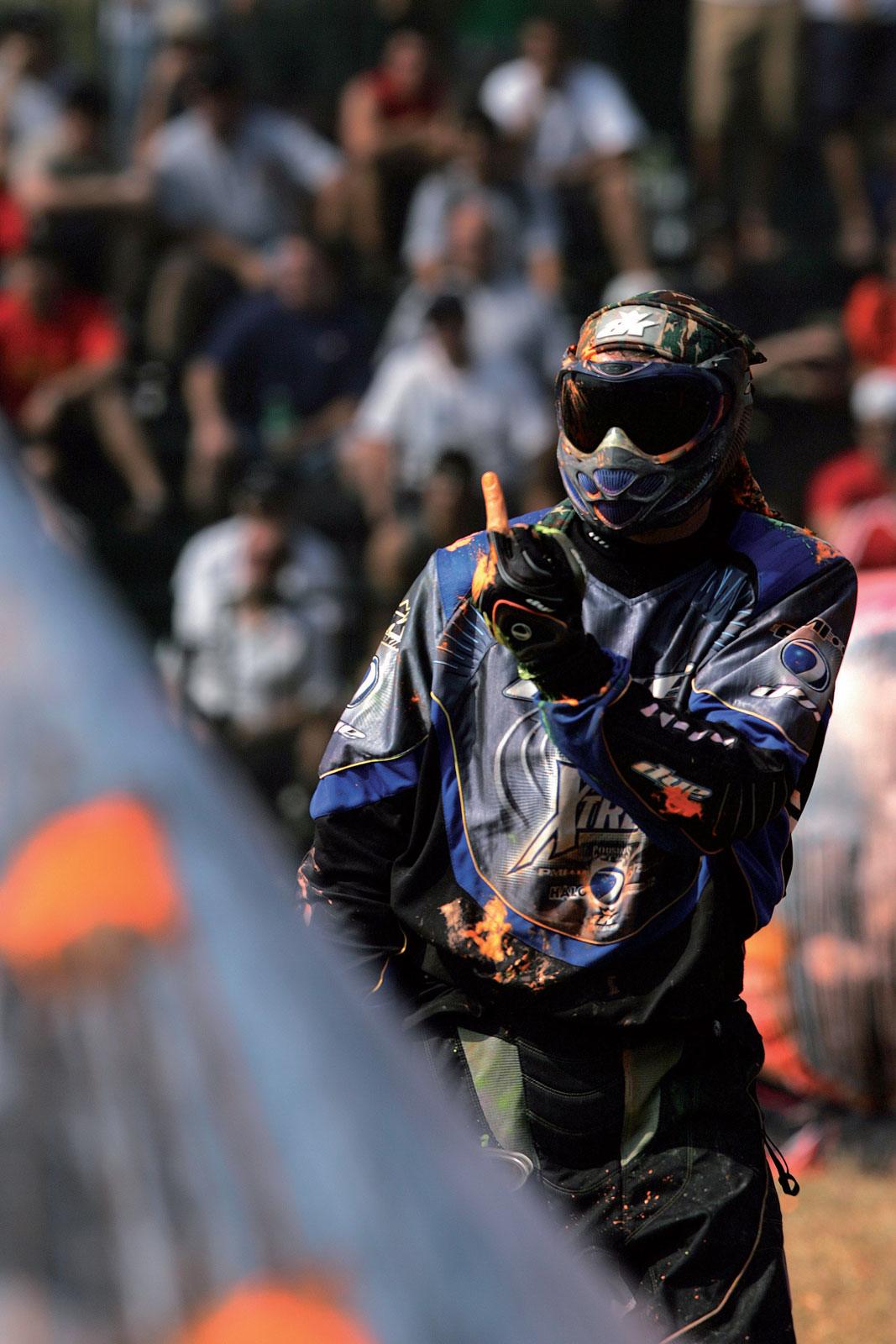
Of course, that isn’t going to stop the captains and players from running out there on the field and arguing until we are blue in the face to try to get what we want. Although this isn’t always the best course of action, it is what we do as captains and players. We are passionate about our sport and we want to win. Lucky for us that the refs are very patient and are willing to listen to us but that doesn’t mean that they are going to change their call. It’s most likely that the call is going to stay the same; no matter how good you are at arguing your case.

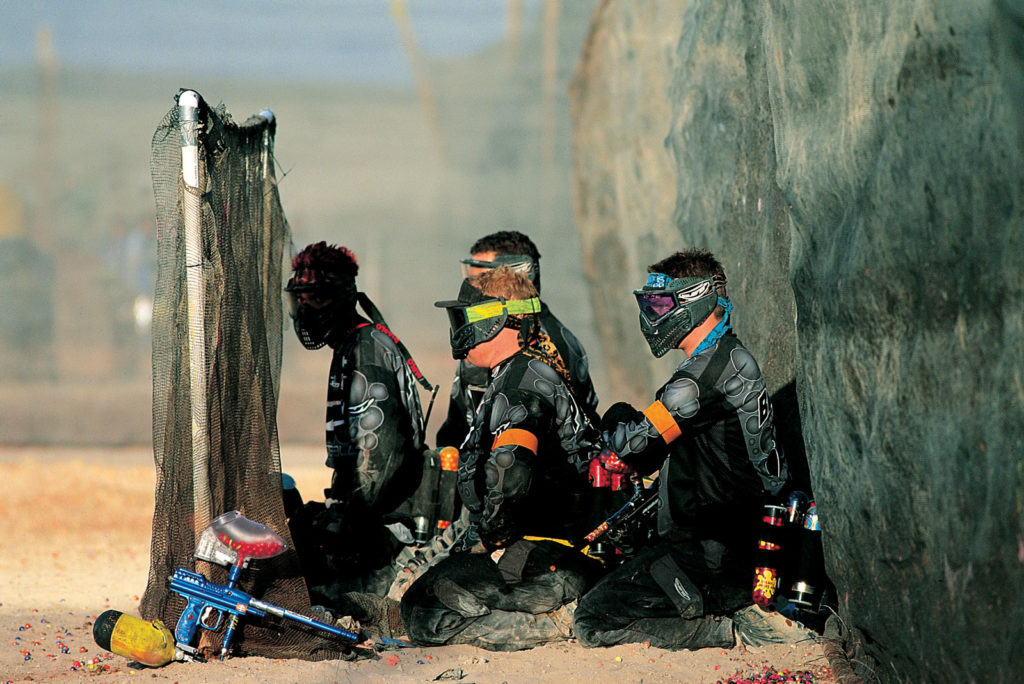
The dead box is the last place you want to be on the field and if you have to go there, you don’t want to be the first one in. The dead box is the area on the field where all the eliminated players go after they have been put out. There is nothing worse than sitting in that box watching the events unfold before your eyes. There isn’t any time when you feel more helpless than when you sit there and watch your team battle while you sit on the sidelines. The amount of time you spend in the dead box maybe only minutes but it seems like hours. Your teammates are out there fighting and you’re already out of the fight. Sometimes, you go to the dead box with a smile on your face because you think you have already won the game. Maybe you went out and shot three or four guys so there is no doubt in your mind that you’re going to win. Then you look across the field and there are just as many of your guys walling off as there are of the opponents’ and you get that sick feeling in your stomach. We all think that when we are in the game, we can still win. We all think that we can do better than those who are out there playing but if that were true then why are we here in the dead box?





The dead box is also where a lot of problems pop up for teams. If you get gamesmen who are not team players and are only thinking about themselves, they can try to divert attention away from themselves by pointing out the flaws in others. It’s easy to sit in the box and criticize other players who are still out there playing. Paintball isn’t like regular sports, where there is always a text book way of doing things. That’s one of the reasons it’s so hard. Guys will sit in the box and say ‘this guy should do this’ or ‘that guy should do that’.

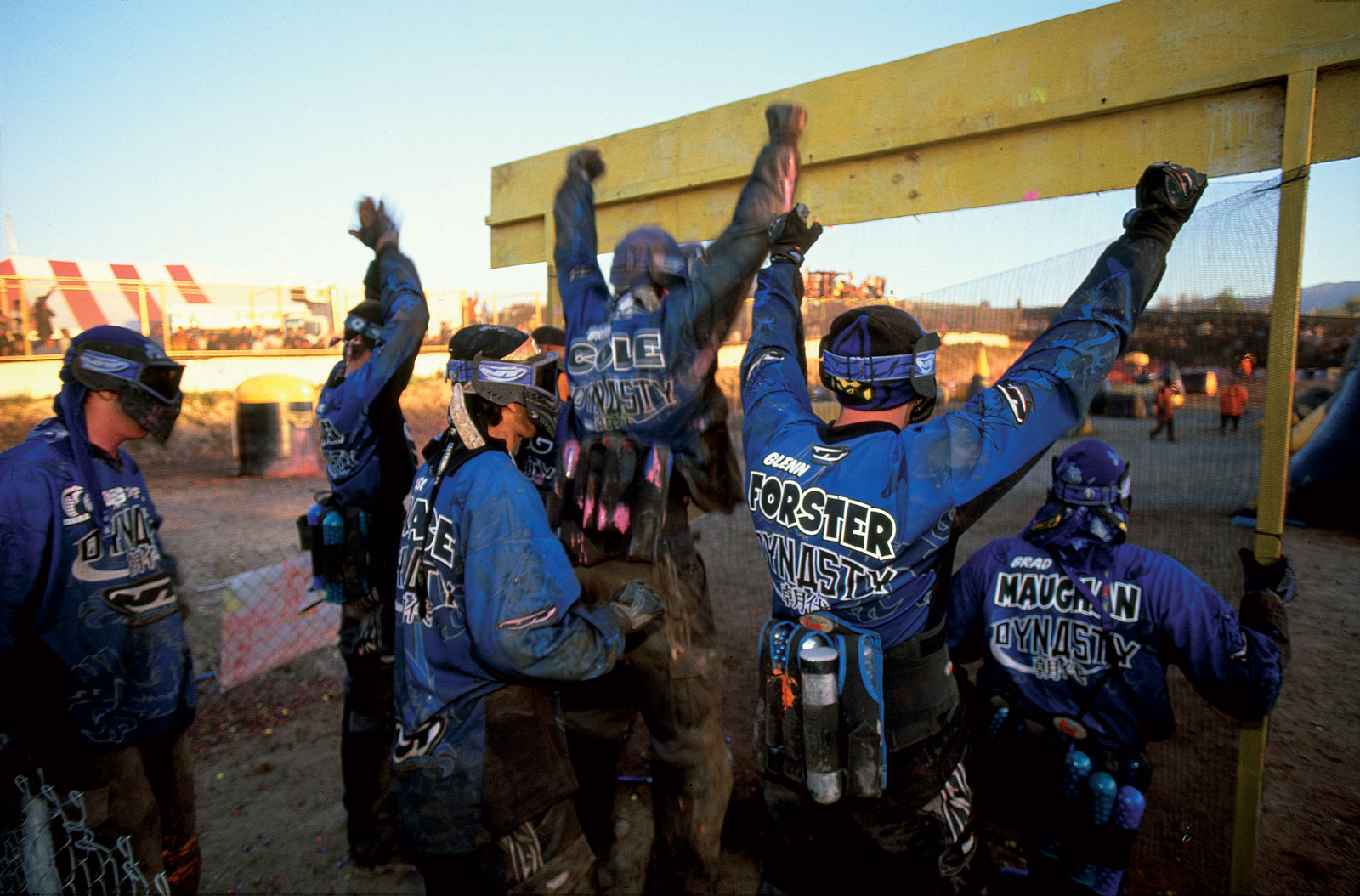


They plant seeds of dissent, which, if left unchecked, cast doubt on the player’s skill and are detrimental to team unity. Some of the best teams and players have had this happen to them, not always from the dead box, but more often than not it springs from there. So my advice is ‘don’t go in the dead box and if you do, go in last’. If someone is in there badmouthing the guys on the field, remind them that they are in the dead box for a reason and they should worry more about why they are in there and less about how everyone else is playing.
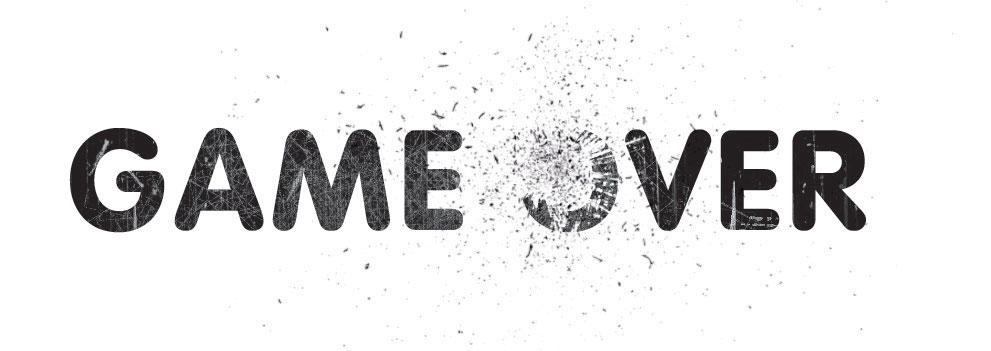
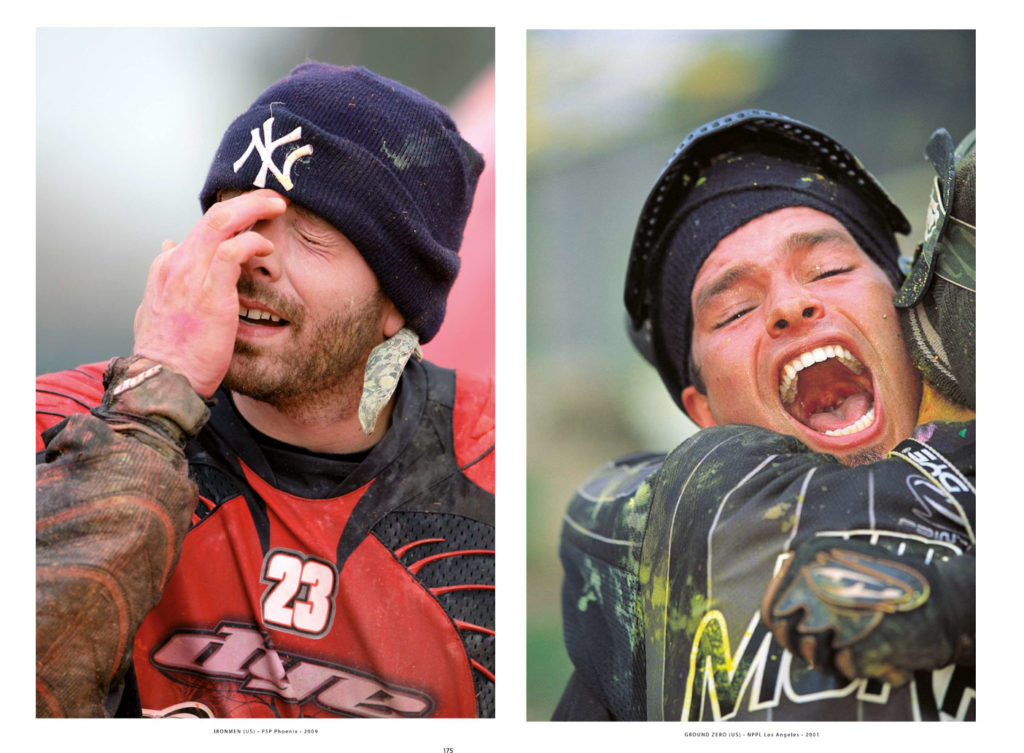
In every game, there is a winner and a loser. No one likes to lose and everyone likes to win. If you’re competitive in this sport, your goal is to win a pro event. It doesn’t matter what league or on what continent.

You just want to win and nothing will stand in your way. You need to accept all of the losses you have to face to get to that first win. The feeling of winning that first event is indescribable, it’s everything you have worked for, it’s the best thing ever and then some. Unfortunately, to get there you have had to lose many games, tournaments and events. You learn along the way that it isn’t always the best team that wins; it’s not always fair or right. It takes something special to win an event; everything has to be just right and then maybe you win. You can have the best team and do everything right and still not win. It’s a paradox that none of us truly understand. I think that the hardest thing to face once you have been doing it for a while is that you don’t always remember the great victories, they just kind of happen. However, the big defeats are devastating, they hurt much more deeply than the joy you feel from winning. Years later, you might not remember who did what or why you won but when you lose, you remember who, what, where and why. That’s probably why so many of us don’t play pro events; we just can’t take all of the heartbreak it takes to finally get there. We struggle, we fail and then we continue until we finally win. Unfortunately, some of us aren’t strong enough to do this and somewhere along the way we lose our drive, our passion and our commitment.





If you’re going to be in paintball and you want to make it to the top and you want to win big events then you have to deal with losing. No one likes it and it doesn’t get better but it’s going to happen and if you want to work past it, you need a plan. My plan has always been to learn from our mistakes as players and as a team. If you lose, it’s only a true loss if you don’t gain anything useful from it. If every time you lose you walk away from it with more knowledge and experience; if you continue to learn with every loss then, eventually, you won’t be losing as much and then not at all. This isn’t easy. In fact, it’s one of the hardest things that we have to do. We have to look honestly at why we lost. You have to break the event down into pieces, analyze those pieces and then figure out how to fix the problem. The easiest but least beneficial solution is to cut players.





This is the easy way out and a short-term solution to a long-term problem. What you need to do is face the facts, figure out why your players were not as good as the other team’s. Figure out what the opponents do to get ready for a game or an event. Think about what your team does and then apply that knowledge to the next game. Use the defeat to improve your game and eventually you will win! .
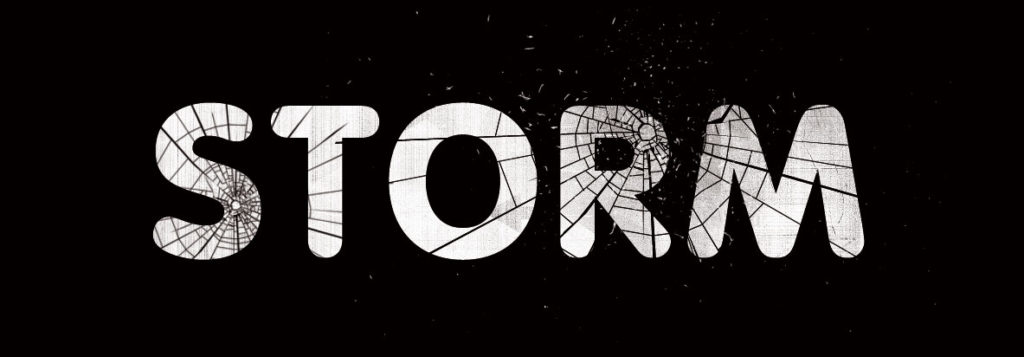
Paintball is a challenging game almost like golf in the sense that you never truly master it. This game is constantly changing and growing. There are a ton of things going on while you are playing weather you’re in the woods or in a big tournament. The only thing that can make it harder then it alreadyis, is would be Mother Nature. Shooting a round ball down a smooth barrel doesn’t make for much accuracy but trying doing that when it raining and breezy then forget about it. Paintball is played best in a dry not humid environment with not to much heat and no wind. Unfortunately that almost never happens. It seems like every time we show up some where its either raining or super hot and a tornado is blowing through. Very rarely do we get perfect paintball weather but when we do it great.



I think that worst storm condition for paintball is the Rain. When the paintballs get wet going into the hopper or sitting in the breach they pretty much get ruined. They will not fly straight no matter how good of a shot you are. They are completely unpredictable so they are next to impossible to shoot. You can’t correct your last shot because the balls are so inacurate you don’t know where they were going. Of course the rain leads to mud. Mud is bad for a few reasons number one it’s hard to run fast and slide which we all really on to get to our bunkers and make our moves. Mud makes everything slippery, people start to fall, drop there markers, it gets crazy. Plus it’s hard to see a little paintball hit someone and break on them when they are completely covered in mud.




So when I said rain was the worst I guess, I meant mud and rain. I guess the only other things that we regularly deal with is wind and oh yeah lighting. Paintball markers are pretty much all mad out of steel or aluminum. It doesn’t really matter they are both very conductive and make really great mini lightening rods. We paintball players are a hardy bunch we play in the rain, mud and wind but when the lighting comes we hide. That’s the cardinal rule for storms in paintball run around have fun in the mud and rain but when the lighting comes hit the road at least until in blows buy.